
by Polina Yan
Scheduling tools run half the modern service economy. Coaches, small clinics, tutors, wellness studios, and consultants rely on booking software to keep their calendars from collapsing. Acuity built a strong early lead, but 2025 looks different. The user base expanded, demands changed, and patience shrank. Across Reddit threads and review platforms, people describe the same friction: slow loading during busy hours, limited customization, and the sense that Acuity works best only if you stay inside the Squarespace ecosystem. That shift is why more teams compare Acuity alternatives before committing to another year.
Some want easier integrations. Others want better branding, smarter automation, or a tool that fits how they actually deliver services. This guide walks through the reasons users move on, the criteria that matter when choosing a replacement, the strongest options available, and what a custom-built solution can offer when ready-made tools can’t keep up.
Why Users Replace Acuity Scheduling

Acuity Scheduling has been around long enough to become the default choice for many small operations. The entry plan usually falls somewhere around $16 per month, with higher tiers reaching roughly $49 as more calendars and features get added. For a solo consultant, that’s manageable. Trouble appears once a business tries to scale or needs a workflow outside Acuity’s narrow lane.
A second piece of context matters here: Acuity became a Squarespace product after the 2019 acquisition. That shift worked well for users already building their websites on Squarespace, but it also created a wave of confusion. Some people search Squarespace Scheduling vs Acuity as if they were unrelated tools. Others ask is Acuity and Squarespace the same thing, trying to understand how tightly the two products overlap. The simplest way to describe it is this: Acuity lives in the Squarespace family, but it still behaves like its own standalone scheduler — with its own advantages and its own ceilings.
Once people look past the branding link, the same pressure points surface again and again:
- Automation runs out of room. Reminders and basic follow-ups exist, but anything beyond simple sequences requires workarounds.
- Branding tools feel thin. Businesses want booking pages that match their identity, not generic forms with basic color swaps.
- Team scheduling becomes pricey. As more calendars get added, the overall subscription jumps fast, pushing people toward tools listed as Acuity Scheduling Competitors.
- Multi-location logic is limited. Clinics, salons, and coaching groups often need resource rules, roles, and complex timetable management. Acuity doesn’t stretch far.
- Squarespace users feel boxed in. Some stay only because it’s bundled. When they try to migrate, the ecosystem makes it harder than expected.
User Pain Points Surfaced Across
The finer details matter even more. Many reviews mention lag during peak usage, confusing time-zone conversions for international clients, and shallow intake form controls. Those issues sound small until they hit real business scenarios.
A yoga studio needs strict class-size limits and waitlists. A consultant juggling different services wants separate intake steps for each. A clinic needs layered permissions so staff only see their own schedules. When these needs collide with Acuity’s ceiling, the workflow breaks. That is the moment people start looking for Acuity alternatives that match the complexity of their daily work instead of forcing them into rigid templates.
How to Evaluate the Right Alternative

Once a team decides to move on, comparing tools becomes overwhelming. Websites pitch similar features, and marketing copy hides the details that matter. These points help filter the noise when reviewing Alternatives to Acuity Scheduling.
Pricing logic defines long-term cost. Some tools charge per staff member. Others price by feature tier. A business with ten calendars will feel a per-seat plan immediately, while a solo operator won’t.
Integration depth shapes workflow. Strong options sync cleanly with Google Calendar, Outlook, Stripe, PayPal, or CRMs. Teams using Zoom or Microsoft Teams need native video integrations, not meeting links pasted manually.
Automation determines how much the tool actually saves time. Good alternatives can handle follow-ups, reminders, cancellations, and sequences that change depending on the service.
Branding and white-labeling influence client perception. Some businesses need a booking page that looks like part of their site—not an embedded widget with limited styling.
Data ownership and export rules matter more than people expect. Vendors that lock down exports create headaches later. Good platforms let teams back up client lists, booking records, and financial reports without obstacles.
Vendor lock-in is a real risk. Some tools work beautifully until a team needs something slightly unusual. If the platform can’t bend, the business ends up switching again.
With these factors in mind, evaluating Acuity alternatives becomes far more honest and less about shiny features.
The Top Acuity Alternatives for 2025
Choosing between the many Acuity Alternatives can feel messy until you compare them in a structured way. Different tools work better for different rhythms: some are built for speed, some for teams, some for people who need fine-tuned branding. Below are five options worth looking at in 2025, each with a clear purpose and transparent pricing so you can decide which one genuinely fits your workflow.
Calendly
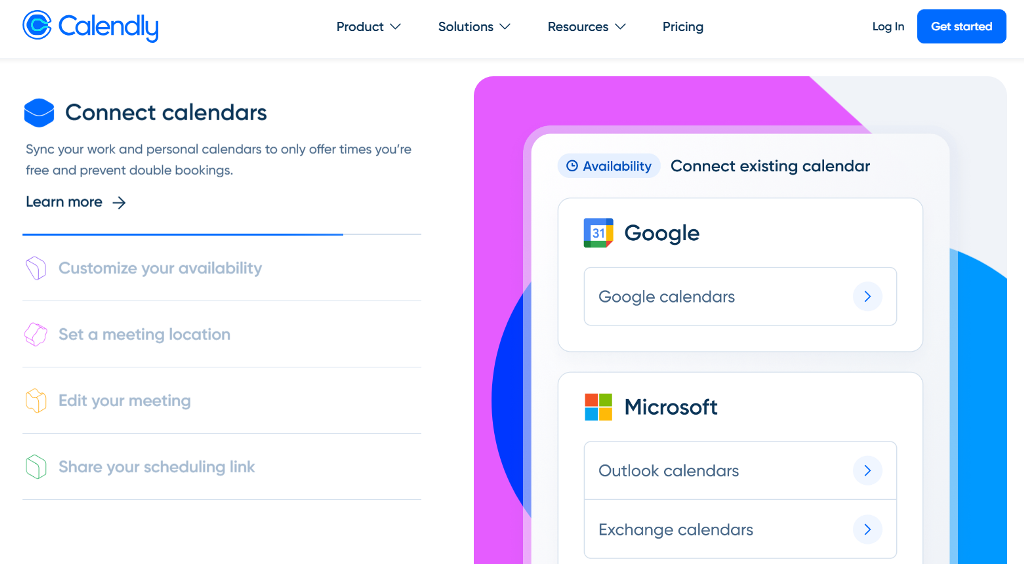
Best for: professionals and teams who want quick scheduling with minimal setup.
Calendly built its reputation on simplicity. You pick your availability, share a link, and clients book without friction. It supports Google and Outlook calendars, plugs into Zoom and Teams, and includes automatic reminders. The tool works especially well for consultants, recruiters, and sales teams that rely on fast back-and-forth scheduling.
Pros:
- Very fast initial setup.
- Large integration library.
- Clean booking pages with predictable behavior.
Cons:
- Branding options feel limited.
- Not ideal for service providers who need intake steps or questionnaires.
Pricing: starts with a free plan; paid seats typically fall into the $10–$16 range.
One of the clearer Acuity scheduling alternative options for straightforward workflows.
Microsoft Bookings
Best for: teams inside Microsoft 365, HR departments, clinics, and corporate training operations.
Bookings works well because it fits naturally into the Microsoft ecosystem. If a team already uses Outlook, Teams, OneDrive, or SharePoint, setup feels almost seamless. Admins can manage staff calendars, service types, and permissions from one interface. Video calls integrate directly into Teams without extra work.
Pros:
- Strong fit for enterprises and corporate teams.
- Deep integration with Outlook and Teams.
- Useful for multi-staff environments that require internal permissions.
Cons:
- Confusing for freelancers or small service providers.
- Customization is limited compared to more flexible tools.
Pricing: included in many Microsoft 365 Business subscriptions; some plans cost $6–$22 per user depending on region and licensing.
Great option for organizations already anchored in Microsoft workflows.
Zoho Bookings
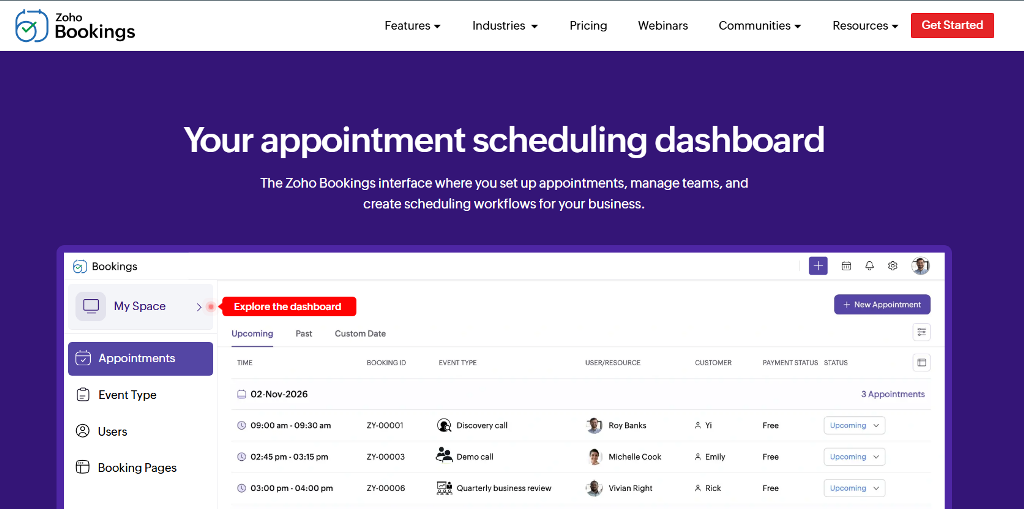
Best for: service teams, coaches, educators, and growing businesses that want automation depth without enterprise pricing.
Zoho Bookings benefits from living inside the broader Zoho suite. Teams can link scheduling with CRM, invoicing, campaigns, and helpdesk tools. Workflows support conditional logic, customized intake, and reminders tied to different service categories.
Pros:
- Automation that adapts to varied appointment types.
- Strong connections to Zoho CRM and external calendars.
- Affordable for multi-staff setups.
Cons:
- UI takes time to master.
- Branding tools are solid but not limitless.
- Sync delays occasionally appear when using many Zoho apps at once.
Pricing: plans range from $6 to $9 per user/month.
Zoho is a strong choice for teams that want deeper workflows without jumping into more expensive enterprise platforms.
Setmore
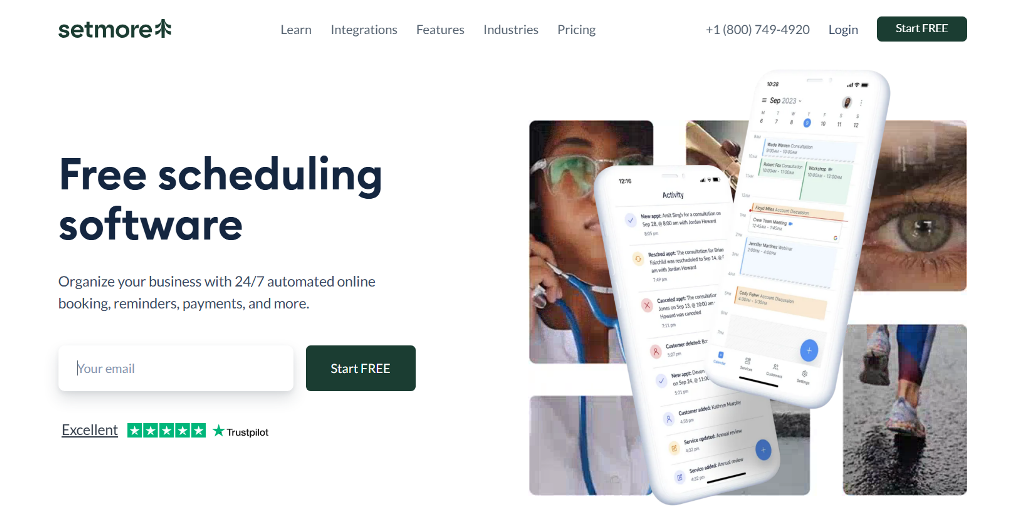
Best for: barbers, fitness coaches, massage therapists, and other small operations that want simple booking with a professional touch.
Setmore is known for its generous free tier and easy learning curve. It connects with Facebook and Instagram, letting clients book directly through social profiles—useful for small businesses that don’t rely on heavy websites. Its appointment pages feel clean and mobile-ready.
Pros:
- One of the best free plans in the category.
- Social media booking tools built in.
- Simple interface that doesn’t overwhelm new users.
Cons:
- Reporting and analytics stay fairly light.
- Limited customization for advanced workflows.
Pricing: free tier available; paid plan lands around $5–$12 per user/month depending on the billing cycle.
Among the most straightforward Acuity alternatives for small, fast-moving service providers.
YouCanBookMe

Best for: educators, consultants, freelancers, and teams that want calendar-driven booking with strong personalization.
YouCanBookMe focuses on customization inside a simple framework. Users can adjust text, layout, email templates, and time-slot rules without touching code. It shines in environments where tight syncing with Google or Outlook matters more than complex automation.
Pros:
- Excellent email and template personalization.
- Intuitive time-slot control.
- Reliable calendar syncing.
Cons:
- Not built for complex multi-location scheduling.
- Limited workflow automation.
Pricing: typically $7–$14 per calendar/month, depending on billing cycle; free plan is available.
A strong pick for teams reviewing Acuity Scheduling Alternatives that emphasize communication over heavy operational structure.
Create a Turnkey Online Booking System With Scrile Connect

All the tools above solve scheduling in their own way. They work best when a business fits the mold they were built for. But many teams don’t. They run unusual appointment types, manage multiple service layers, or need a branded client experience that prebuilt software can’t offer. That’s where Scrile Connect comes in—not as another booking app, but as a custom-built system shaped around the business itself.
Scrile Connect is a development service, not a SaaS subscription. The team builds a private scheduling platform with the exact features a business needs: unique intake flows, multi-role dashboards, resource-based scheduling, class and group booking logic, membership areas, integrated payments, messaging, or anything else required. Because everything is custom, there are no constraints on layout, branding, automation, or workflows.
Key advantages:
- Custom UI and branding that match the business perfectly.
- Scheduling flows built from scratch for the service type.
- Payment logic, subscriptions, bundles, or credit systems.
- Multi-staff permissions, internal notes, and audit tools.
- API-based structure for future integrations and expansion.
- Full data ownership with no platform lock-in.
For businesses that outgrow Acuity—or any replacement—Scrile Connect offers a way to build an alternative to Acuity Scheduling that truly fits how the team works.
Conclusion
The market for scheduling tools is broader than ever, with Acuity Alternatives available for nearly every business stage and need. From simple booking apps to robust client management systems, the right solution depends on your goals and workflow. When out-of-the-box tools no longer fit, custom development becomes the smartest next step. Scrile Connect offers tailored platforms designed to scale with your business.
Explore what Scrile Connect can build for you — and move beyond limitations.
FAQ
What’s better than Acuity Scheduling?
Different tools excel in different areas. Calendly handles quick booking; Microsoft Bookings works well inside corporate Microsoft 365 setups; Zoho Bookings adds automation and CRM links; YouCanBookMe focuses on personalization; Setmore gives small businesses an easy free option. These are the main competitors among modern Acuity alternatives, and the right choice depends on the workflow.
Is there a free version of Acuity Scheduling?
Acuity doesn’t offer a permanent free plan, but new users get a free trial. It’s enough to test basic booking, reminders, and calendar syncing before committing to a paid tier.
Is Calendly or Acuity better?
Calendly fits teams that want fast, simple scheduling with clean integrations and minimal setup. Acuity suits people who need packages, memberships, or deeper client management.
Polina Yan is a Technical Writer and Product Marketing Manager, specializing in helping creators launch personalized content monetization platforms. With over five years of experience writing and promoting content, Polina covers topics such as content monetization, social media strategies, digital marketing, and online business in adult industry. Her work empowers online entrepreneurs and creators to navigate the digital world with confidence and achieve their goals.

by Polina Yan
The landscape of Chatfuel competitors is expanding fast as brands seek automated conversations without losing control of tone, data, or workflows. When businesses ask what is Chatfuel, they generally mean a Messenger- and Instagram-first bot platform that lets non-developers build branching flows, keyword triggers, and broadcast sequences. Chatfuel handled early growth in chatbot adoption, but many teams now look toward alternatives that offer more flexibility, richer integrations or better ownership.
That shift matters because the global chatbot market is on a steep upward curve—valued at US $7.76 billion in 2024 and projected to reach around US $27.29 billion by 2030, growing at a 23.3 % CAGR through 2025-30.
In this article, we’ll walk you through five leading Chatfuel competitors, compare their features and pricing side-by-side, and then explain when and why a custom development path makes strategic sense.
Chatfuel in Context
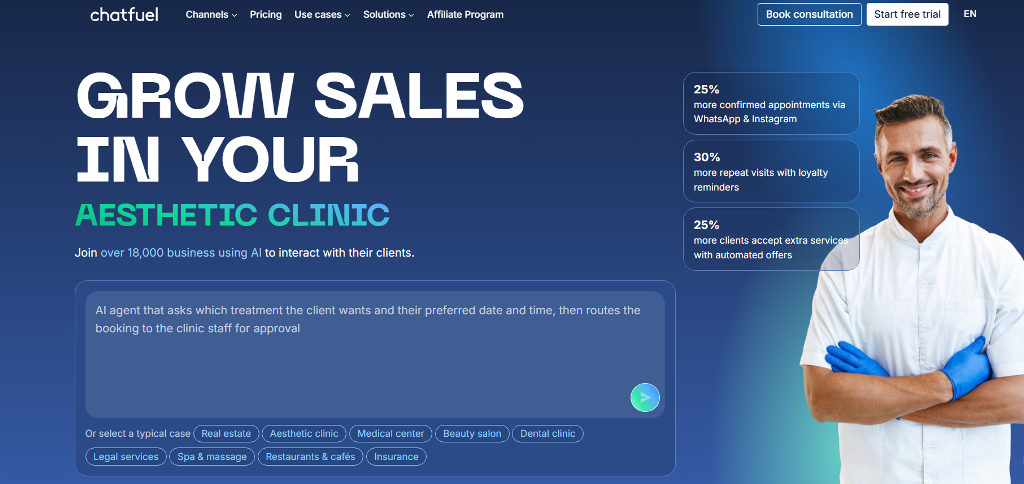
Chatfuel grew popular by giving small teams a quick way to design chat flows without touching code. The platform focuses on channels where automated messages matter most—Facebook Messenger, Instagram DM, and, more recently, WhatsApp. Its builder uses blocks, buttons, keyword triggers, and simple logic steps to shape conversations. There’s also AI autofill for short replies and a set of broadcast tools for announcements or promotional pushes. For many early adopters, it functioned as a chafuel chatbot starter kit: fast to launch, easy to maintain, affordable to scale in the beginning.
Pricing stays within a predictable range. Plans typically start around $24 a month for small audiences and grow toward the $400 mark once brands need higher user limits, more channels, or priority features. The platform works well for straightforward automation, and you’ll find plenty of Chatfuel examples across retail, fitness, and small service businesses—FAQ bots that reduce support tickets, lead-capture flows that qualify customers, and simple routing setups that hand off to human agents.
Still, teams run into constraints once the use case becomes more than a linear script. Some limitations show up early:
- restrictions on branding the interface or embedding the bot into custom environments
- rigid workflows that don’t adapt well to unusual sales funnels or niche product logic
- limited control over data storage and how user information is handled
- dependency on Meta’s rules, which can change the behavior of the bot overnight
These friction points explain why businesses often explore Chatfuel competitors before making a long-term commitment. The moment a company needs deeper integrations, multi-language logic, or ownership of its data, the search for alternatives begins.
Chatfuel Competitors
Chatfuel works well for simple flows, but teams often reach a point where they need more channels, deeper logic, or stronger AI. That’s where the leading Chatfuel competitors start to make sense. Below are five options that show how different builders approach automation—each with its own pricing, strengths, and trade-offs.
ManyChat

ManyChat is usually the first name people meet when comparing Chatfuel competitors, mostly because it focuses heavily on growth tools for Instagram and Facebook. The interface leans toward creators and small shops that want automation without drowning in technical steps.
Features and channels
ManyChat supports Instagram DM, Facebook Messenger, WhatsApp, and web chat widgets. It offers a visual flow builder, comment auto-replies, story-triggered workflows, basic AI replies, and tools that turn post engagement into leads. The platform also integrates with Shopify, HubSpot, and Google Sheets, which helps teams sync marketing actions with store activity.
Pricing
ManyChat’s free plan covers basic IG + Messenger tools. Paid plans start around $15/month, but costs rise with WhatsApp usage and higher contact volumes, usually landing between $25–$65/month for active small businesses.
Pros
- growth-friendly automations tied to Instagram posts and comments
- simple visual editor suited for non-technical marketers
- good templates for lead capture and appointment flows
- reliable integrations for e-commerce syncs
Cons
- WhatsApp pricing is tied to Meta’s message fees
- limited control over data portability
- branding depends on platform rules
- more lightweight AI compared to newer builders
ManyChat feels more marketing-driven, while Chatfuel leans on structured logic blocks. For teams wanting IG-centric workflows, ManyChat often solves gaps Chatfuel can’t cover.
Botsonic

Botsonic sits on the AI-first side of Chatfuel competitors, designed for teams that want GPT-powered conversations trained on their own data. It feels less like a classic rule-based builder and more like a lightweight LLM interface that you can deploy without engineering work.
Features and channels
The core feature is data ingestion: you upload PDFs, URLs, or text, and Botsonic trains an internal knowledge layer that shapes replies. It connects to websites through an embeddable widget and supports API access for custom deployments. It’s strong for FAQ bots, support assistants, and any use case where answers must reflect documentation rather than canned flows.
Pricing
Paid plans usually start around $16–$41/month, depending on message volume, data limits, and branding controls.
Pros
- quick setup for AI-driven assistants without writing flows
- supports custom knowledge bases with decent accuracy
- widget branding options for website integration
- strong retrieval quality for documentation-heavy businesses
Cons
- conversation style depends heavily on GPT behavior
- fewer multi-channel options compared to other builders
- not ideal for complex funnels that require branching logic
- costs increase when traffic grows
While Chatfuel relies on structured blocks, Botsonic offers flexible AI responses. It attracts teams who prefer natural-language agents over rigid menu flows.
Tidio

Tidio sits somewhere between live chat, automation, and AI support. Among Chatfuel competitors, it’s one of the strongest for customer service because it blends human agents and bots inside the same panel.
Features and channels
Tidio supports website chat widgets, Instagram, Messenger, email routing, and a growing set of AI features. Lyro—their AI assistant—trains on your help center content and reduces repetitive workload for support teams. The system also includes ticketing, operator dashboards, and simple marketing automations.
Pricing
Paid plans usually start at $24/month for basic automation, while Lyro AI add-ons push total costs into the $49–$749+ range, depending on usage.
Pros
- strong combination of live chat + automation
- Lyro AI reduces support workload for common questions
- ticketing tools included, good for small support teams
- clean, modern interface
Cons
- advanced AI features cost extra
- limited flexibility for multi-step marketing funnels
- branding control depends on plan
- WhatsApp support is still developing
Tidio is better suited for support-heavy teams, while Chatfuel focuses more on predefined sequences. For businesses with active operator teams, Tidio frequently wins.
Landbot
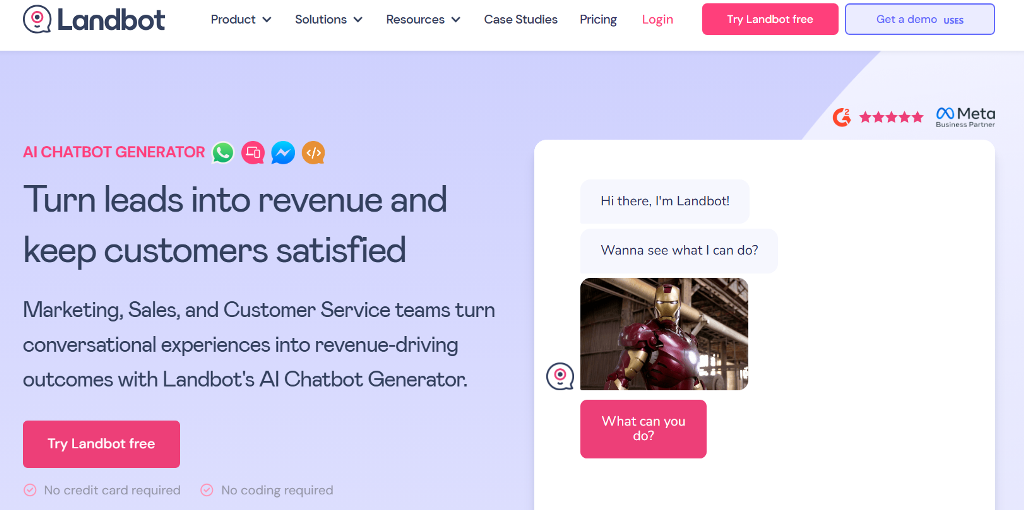
Landbot stands out among Chatfuel competitors because of its visual builder. Everything is laid out as draggable blocks that resemble a mind-map, which makes complex flows easier to reason about. It’s a favorite for teams that want custom logic without writing code.
Features and channels
Landbot supports web chat widgets, WhatsApp, Messenger, and API-based deployments. Its strength is the combination of conditional logic, variables, and integrations with tools like Zapier, Make, HubSpot, and CRMs. It also includes AI modules for semantic intent detection and knowledge-trained responses, but its biggest selling point remains the flexibility of the builder.
Pricing
Landbot starts around $40/month, with WhatsApp consumption fees added on top. More advanced plans for teams and enterprises run into the $200–$400+ range depending on usage and automation volume.
Pros
- one of the best visual flow builders in this category
- strong logic and variable handling for custom experiences
- multi-channel support with reliable WhatsApp integrations
- good fit for companies that need granular funnel control
Cons
- pricing climbs fast for WhatsApp-heavy operations
- AI features are improving but still secondary
- setup takes longer than simpler lightweight tools
- branding options limited on lower tiers
Landbot appeals to teams who need deeper logic than Chatfuel allows—especially when flows go beyond simple branching trees.
Customers.ai (MobileMonkey)
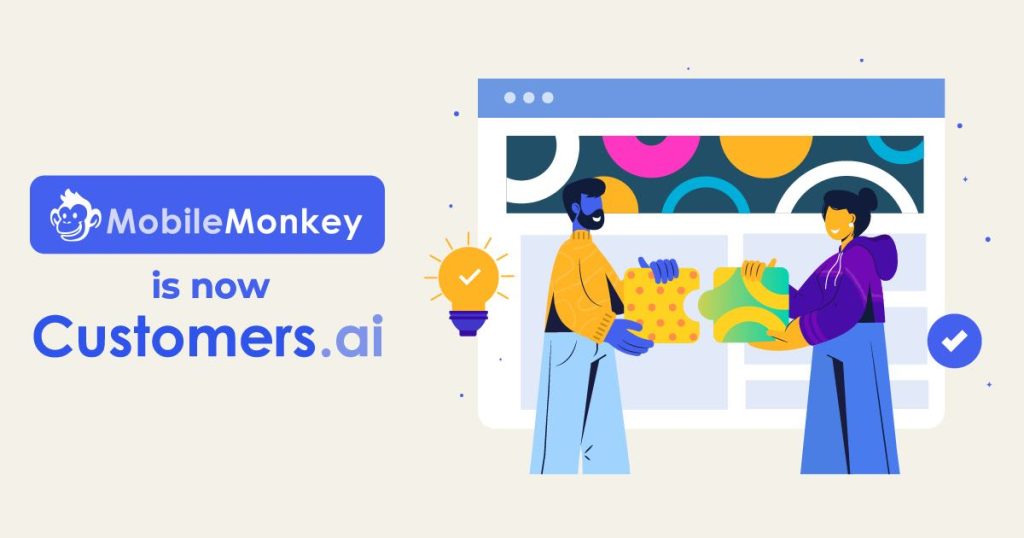
Customers.ai positions itself as a multichannel messaging hub, making it one of the more marketing-focused Chatfuel competitors. It’s built for businesses that want to automate conversations across Instagram, Messenger, SMS, and web chat while keeping all interactions in one inbox.
Features and channels
It includes lead capture tools, drip sequences, omnichannel chat, unified inbox, growth widgets, and automation templates. Customers.ai also offers agency-focused features like client workspaces, white-labeled reports, and team management. AI add-ons include GPT-powered message generation and auto-responses for DM engagement.
Pricing
Customers.ai’s pricing isn’t as transparent as others. Plans typically start at $19–$49/month, but Instagram- and SMS-heavy teams often pay more due to volume-based messaging costs.
Pros
- omnichannel messaging hub with unified inbox
- strong set of tools for agencies and marketers
- Instagram DM automation is reliable
- white-labeling available on higher plans
Cons
- pricing varies depending on channel usage
- fewer native integrations compared to other platforms
- interface can feel cluttered for small teams
- SMS workflows can become expensive
Customers.ai covers more channels than Chatfuel and is better suited for digital agencies or growth marketers managing multiple brands.
Comparison Table
| Feature / Tool | Chatfuel | ManyChat | Botsonic | Tidio | Landbot | Customers.ai |
| Channels | Facebook, Instagram, WhatsApp | Facebook, Instagram, WhatsApp, Web widget | Website widget, API | Website widget, Instagram, Messenger, Email | Website widget, WhatsApp, Messenger, API | Facebook, Instagram, SMS, Web widget |
| AI tools | Basic AI replies, NLP add-ons | Basic AI replies, GPT-style add-ons | GPT-based AI trained on your data | Lyro AI assistant trained on help content | NLP intents, AI modules for semantic routing | GPT-based DM replies, AI prompts for messaging |
| Customization depth | Medium: block-based flows | Medium: visual flows with growth tools | Medium–High: AI behavior plus prompt settings | Medium: flows plus support automation | High: granular visual builder with logic & vars | Medium: omnichannel flows and targeting |
| Branding | Limited to widget + channel styling | Limited on lower tiers, better on higher | Good widget branding, limited host control | Widget styling, basic white-label options | Strong control over widget and experience | White-label and agency branding on higher plans |
| Starting price | ~$24/month | Free tier, paid from ~$15/month | Paid from ~$16–$41/month | Paid from~$24/month | Free tier, paid from ~$39/month | Paid from ~$19–$49/month |
When a Custom Build Outgrows Templates and How Scrile Connect Fills the Gap

Teams often start with simple chatbot builders, then run into limits the moment their workflows become more specific. Even the strongest Chatfuel competitors cannot support deep branding, custom business logic, or the kind of monetization many platforms rely on. This is usually the point when companies shift from subscription tools to a custom build, and Scrile Connect fits that need because it is not a SaaS product. It is a development service that creates fully owned, private, white-label systems.
Scrile Connect gives companies full control over how their chatbot platform looks, behaves, and integrates. The product is shaped around the client’s business rather than forcing a business to adapt to templates. This includes branded interfaces, unique onboarding flows, payments, gated content, and real-time communication tools that Chatfuel-style builders never support out of the box.
These are the areas where custom development through Scrile Connect becomes practical:
- 100% white-label visual setup with the client’s logo, domain, and design, including custom UI for chat, onboarding, and access levels
- Built-in monetization features, such as subscriptions, tipping, pay-per-view, private video calls, live streams, and content bundles for businesses that need revenue, not just automation
- Flexible payment processing through Stripe, PayPal, CCBill, crypto gateways, PayId19, or custom providers required in specific countries
- Secure data handling with GDPR-ready hosting, moderation tools, and optional age-verification flows for regulated industries
- An admin dashboard for managing users, payouts, analytics, and earnings
- Custom integrations and extended rules, including API-based workflows, CRM syncs, internal systems, and specialized logic that templates cannot support
Scrile Connect has built entire platforms based on these components: multilingual CRM bots, support desks with payments, marketplace onboarding systems, community chat platforms with monetization, and full “Chatfuel-style” builders branded entirely for the client. It becomes a long-term solution that goes beyond what most Chatfuel competitors can deliver.
Conclusion
Comparing different chatbot builders helps teams understand where the limits of template-based systems begin. Many tools handle simple flows well, but businesses eventually need deeper logic, stronger branding control, and ownership of their data. That is where a custom solution becomes more strategic than sticking to presets. Founders who want a scalable, fully branded chatbot experience can work with Scrile Connect to build something shaped around their product rather than a generic framework. Get in touch with the Scrile Connect team to explore your custom build.
Polina Yan is a Technical Writer and Product Marketing Manager, specializing in helping creators launch personalized content monetization platforms. With over five years of experience writing and promoting content, Polina covers topics such as content monetization, social media strategies, digital marketing, and online business in adult industry. Her work empowers online entrepreneurs and creators to navigate the digital world with confidence and achieve their goals.

by Polina Yan
Think of your website not just as a place to sell but as a fully optimized, frictionless payment hub. No one likes a complicated checkout process—customers expect fast, secure, and effortless transactions. This is where payment gateway integration becomes essential, acting as the invisible bridge between buyers and businesses, ensuring smooth and secure payments.
Adding a payment gateway to your website is not just about processing the transaction but instilling confidence in the customer so they can make their purchases effortlessly while the entire operation remains efficient. An optimized integration system would make checkout more convenient and trustworthy and reduce the chances of cart abandonment.
Mastering how to integrate a payment gateway can be a game-changer. Whether you want to set up an online store, deliver digital services, or manage subscriptions, getting the integration right ensures your business is working and your customers are satisfied. In this guide, we will walk through the crucial steps, best practices, and expert insights that will guide your payment gateway integration experience.
Understanding Payment Gateways

Integration of payment gateway is the most important aspect of any web-based business. A payment gateway is an encrypted link between a payor’s source of funds and a merchant bank account where secure and smooth transactions are processed in seconds only. It verifies payment details, settles authorizations and transfers funds in seconds only. Without integration, web payments would be cumbersome, insecure and error-prone.
How Payment Gateways Work
During the purchase process by a consumer, the payment gateway encrypts the payment details and forwards the details securely to the concerned financial intermediaries. The payment processor instructs the bank or payment network to accept the transaction or decline it. Once approved, the payment gets transmitted into the business account. Transactional convenience and industry-approved payments based on security standards are facilitated by payment platform integration.
Types of Payment Gateways
Choosing the right payment gateway depends on business needs. The two primary types are:
Hosted Payment Gateways:
- Redirect customers to an external payment provider’s secure page.
- Simplifiy compliance and security management, as the provider handles sensitive data.
- Common examples: PayPal, Stripe Checkout, and Skrill.
- Best suited for small businesses or startups looking for a quick and secure solution without handling complex payment security requirements.
Integrated (On-Site) Payment Gateways:
- Transactions happen directly on the business’s website, offering a seamless user experience.
- Require advanced security measures, such as PCI DSS compliance, but provide full control over branding and customization.
- Common examples: Stripe API, Authorize.net, and Braintree.
- Ideal for larger businesses that require a professional, fully branded checkout process.
It is an imperative of successful payment gateway integration to enhance consumer confidence and facilitate secure and seamless transactions. Regardless of whether a hosted solution or integrated platform is utilized, companies must emphasize efficiency, security, and user experience in implementing their payment platform integration in a bid to enhance conversions and preserve consumer confidence.
Choosing the Right Payment Gateway
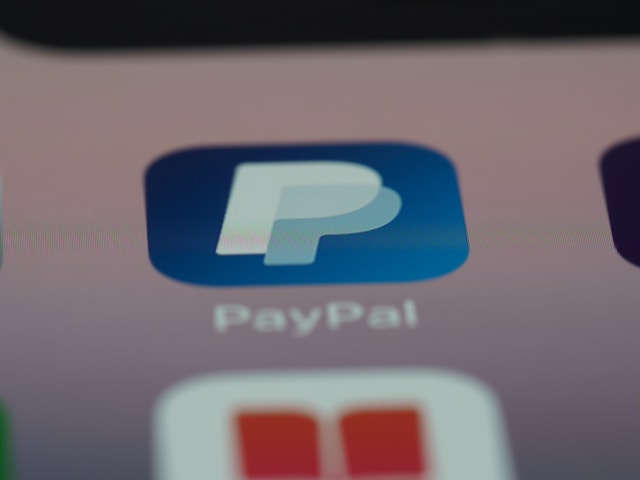
Picking an appropriate payment gateway determines success or failure in an online business. With an endless number of gateways to sort through, business concerns need to exercise prudence in making a choice when implementing a system. Seamless payment gateway integration guarantees easy transactions, client satisfaction and retention, and user-friendliness.
Key Factors to Consider
When considering how to integrate a payment gateway into their business, companies should consider the following factors:
- Transaction Fees – Each payment gateway charges differently per transaction. Some have fixed percentages such as PayPal, but others use volume-based pricing such as Stripe. High-volume companies have to be on the lookout for such fees.
- Security Features – Encryption and fraud prevention and PCI DSS compliance are needed. A secured gateway protects client information and reduces chargebacks.
- Supported payment methods – The payment gateway should support multiple payment methods such as bank transfers, e-wallets (Google Pay and Apple Pay), and others such as cryptocurrency and bank transfers.
- Integration Issues – Some providers have plug-and-play options and others require custom development. It helps to have an idea on how to integrate a payment gateway in a site prior to selecting a provider.
- Settlement Time – Different providers have different times for moving money into a business account. Some payment gateways send payment in real-time and others take a few days.
Comparing Popular Payment Gateways
When businesses decide to integrate a payment gateway, they should compare industry leaders based on their features and pricing models:
- Stripe – Best for developers and businesses needing a highly customizable, API-driven integration.
- PayPal – A widely recognized provider with simple setup but higher transaction fees. Ideal for small businesses and international transactions.
- Square – Excellent for brick-and-mortar stores with an online presence, offering both POS and e-commerce solutions.
- Authorize.net – A solid choice for businesses needing a traditional merchant account with strong security features.
Selecting an appropriate gateway involves a compromise between user experience, security, and expense. An appropriate provider facilitates checkout easily and maintains the consumer engaged and the transaction secure.
Integration Process Detailed
Online payment gateway integration can be made to seem complicated, yet with an appropriate methodology, the payment process of the customers can be made smooth and trouble-free by the companies. Opting for either a hosted facility or an integrated API-based payment gateway platform, a step-by-step approach ensures an implementation free from complications.
Step-by-Step Guide to Integrate a Payment Gateway in a Website
- Choose the Right Payment Gateway
- Evaluate providers based on transaction fees, security, and ease of integration.
- Consider whether a hosted or direct integration suits your business model.
- Create a Merchant Account
- Some gateways require businesses to set up a merchant account to process transactions.
- Providers like Stripe and PayPal offer built-in merchant services, simplifying this step.
- Obtain API Keys
- After registration, the payment provider issues API keys, which authenticate communication between your website and the gateway.
- Most providers offer separate keys for testing (sandbox mode) and live transactions.
- Integrate Payment Gateway in Website
- Hosted gateways require simple redirection to an external payment page.
- API-based integrations require backend setup to process payments directly within the site.
- Implement Payment Processing Workflows
- Configure the gateway to handle different transaction types: one-time payments, subscriptions, refunds, etc.
- Ensure error handling is in place to manage failed transactions or payment declines.
- Test the Payment System
- Use sandbox mode to simulate real transactions before going live.
- Check for potential failures, security vulnerabilities, and user experience issues.
- Go Live and Monitor Transactions
- Once testing is complete, switch to live mode and monitor real transactions.
- Set up alerts for failed payments or suspicious activity.
Technical Considerations for Payment Gateway Integration
- APIs and SDKs – Most modern payment processors, including Stripe, PayPal, and Square, have powerful APIs and SDKs in development languages such as Python, JavaScript, and PHP to simplify development.
- Backend Configuration – Companies utilizing API-based gateways need to set up secure backend processing to manage payment requests and verify responses.
- Security Compliance – Stay PCI DSS compliant by encrypting transaction data and facilitating secure HTTPS connections.
- Webhook Implementation – All gateways support webhooks to notify businesses of successful payments, chargebacks, and refunds as well as to enable automated transaction notifications.
Integration of an online payment gateway in an appropriate manner builds user confidence, reduces payment inconvenience, and ensures secured transactions. Following the best practices and putting the technology first, business companies are able to create a strong and smooth payment system for business development.
Security and Compliance

Handling online transactions requires more than just a functional system—it demands strong security protocols to protect both businesses and customers. A well-executed payment gateway integration process ensures that sensitive payment data remains secure while complying with industry standards like PCI DSS (Payment Card Industry Data Security Standard). Businesses that neglect these security protocols expose themselves to fraud, data breaches, and financial losses, which can considerably impact their business and reputation.
To provide a secure online payment integration, encryption, tokenization, and secure authentication protocols must be the top priority for businesses.. Encryption ensures that customer payment details are transmitted safely without being intercepted by malicious actors. Tokenization replaces actual card details with a unique token, reducing the risk of data exposure. Multi-factor authentication adds another layer of protection, verifying the legitimacy of transactions before approval.
Security never stops at integration—it must be continuous and subject to periodic updating. Regular system audits identify weak points before they can be exploited. Fraud protection features, such as monitoring unusual payment patterns, block unauthorized payments. Secure facilities and firewalls hosting also shield payment details against cyber attacks. By being continuously on guard and taking decisive security measures, organizations maintain their payment gateway compliant and also immune to new threats that may arise.
Troubleshooting Common Issues
Integrating a website with a payment gateway may be accompanied by issues even with a properly designed setup. The most common issue is transaction failure because of the improper setting of APIs or connection issues between the payment gateway and the business’s backend system. Payment rejections based on fraud detection or insufficient funds also frustrate customers and lead to incomplete transactions.
Slow processing is another frequent issue. Payment authorizations can be delayed due to the server workload being heavy or because the site infrastructure and gateway are incompatible. Security errors on the assumption that gateways will reject transactions as they are probable threats and would need to be examined manually or further subject to verification procedures need to be expected by the merchants.
These problems must be addressed through careful troubleshooting. Ongoing API testing and monitoring detect problems prematurely. Software and security updates minimize compatibility and fraud detection issues. Proper customer communication, such as providing additional payment options in case of a failed transaction, improves customer experience. By tackling these integration challenges adequately, businesses are able to guarantee a smooth and stable payment system, without the disruption of transactions.
Why Choose Scrile for Your Integration Needs
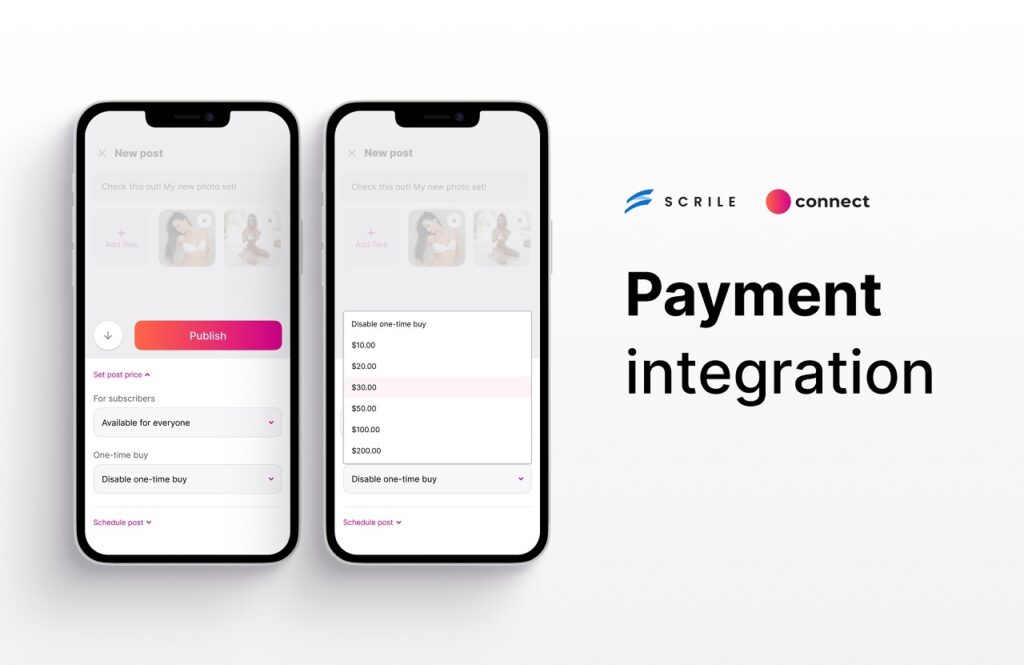
A one-size-fits-all payment gateway might be adequate for some businesses, but most businesses need a solution tailored to their operations. Scrile payment gateway integration is customization-focused, allowing businesses the freedom to create a system that is bespoke to their payment processing needs. From processing one-time payments, recurring subscriptions, or multi-vendor payments, Scrile enables seamless, secure, and scalable integration.
Custom Solutions by Scrile
- Flexible payment processes: Tailor the payment gateway to your business model, whether an online store, a subscription-based digital business, or a tiered-pricing site.
- Multi-currency support: Allow global transactions without friction, ensuring smooth payments across different regions.
- Enhanced fraud protection: Implement security features tailored to your industry to minimize risks and chargebacks.
Benefits of Choosing Scrile
- Industry expertise: Scrile has experience in payment solution integrations for social media platforms, SaaS products, online marketplaces, and high-risk industries where default gateways are unable to provide what is required.
- Streamlined transaction processing: Minimize declined payments and frictional checkout with an optimized gateway integration.
- Scalability and compliance: Get ahead of evolving regulations while having a system that grows with your business.
Long-Term Reliability and Support
- Continuous monitoring and updates: Payment gateways require adjustments over time. Scrile ensures ongoing optimization to maintain performance.
- Technical support and troubleshooting: Get expert assistance when needed, preventing disruptions in transactions.
- Adaptability to new payment technologies: As new methods emerge, Scrile helps businesses integrate them seamlessly.
With Scrile payment gateway integration, businesses gain more than just a payment processor—they get a customized, reliable system that enhances revenue, security, and user experience.
Conclusion
Professional payment gateway integration is the cornerstone of smooth transactions, security, and customer satisfaction. The right gateway enables smooth payment processing, reduces declined transactions, and enhances business trust. Every business having different requirements makes the customized approach the differentiator.
Scrile payment gateway customized solutions are designed to meet specific business needs for efficiency and security. For a hassle-free and scalable payment system, explore Scrile’s expert solutions today. Let their professionals help you design a secure, fully integrated payment gateway that optimizes your customer experience and long-term success.
Polina Yan is a Technical Writer and Product Marketing Manager, specializing in helping creators launch personalized content monetization platforms. With over five years of experience writing and promoting content, Polina covers topics such as content monetization, social media strategies, digital marketing, and online business in adult industry. Her work empowers online entrepreneurs and creators to navigate the digital world with confidence and achieve their goals.

by Polina Yan
Social media isn’t slowing down—it’s multiplying in influence, reach, and revenue. What started as a place to post photos and status updates has become a core infrastructure for communication, commerce, entertainment, and learning. From micro-communities to influencer-led businesses, the demand for specialized social platforms keeps expanding.
According to Spherical Insights, the global social media market size is projected to exceed $815 billion by 2033, with a compound annual growth rate of 14% between 2023 and 2033. At the same time, Statista reports that global social media users are expected to reach 6 billion by 2028—nearly three-quarters of the planet’s population.
That scale brings opportunity. If you’re exploring how to make a social media app, now is the time to get serious. This article will walk you through the key decisions, features, and development options required to turn a big idea into a successful social platform in 2025.
Identifying Your Niche and Target Audience

If you’re serious about learning how to make a social media app, the first step isn’t writing code—it’s figuring out who you’re building it for. With thousands of platforms already crowding app stores, the only way to stand out in 2025 is to build with purpose and specificity.
Generic platforms trying to appeal to everyone often end up serving no one particularly well. Instead, the most successful newcomers focus on a niche. That could be a community of LGBTQ+ users looking for safe, inclusive spaces. It could be designed for influencers and creators who want more control over how they engage and monetize their audience. Or maybe it’s aimed at hobbyists—gamers, gardeners, collectors—who want platforms built around their shared interests rather than algorithm-driven feeds.
Some examples of strong niche directions in 2025 include:
- LGBTQ+ communities looking for moderated, safe social spaces
- Influencers and creators wanting direct-to-audience control with monetization
- Professional consultants needing private messaging, scheduling, and video tools
- Fitness and wellness groups who want event-based and content-sharing features
- Hobbyists forming communities around shared passions like books, fashion, or gaming
Even professionals are carving out their own platforms in fields like coaching, nutrition, and finance. These users need tools that blend social interaction with content hosting, event scheduling, or private messaging. Understanding exactly what your audience needs—and what annoys them about mainstream platforms—will help you shape the right features from day one.
When you create your own social media platform, you’re not just building an app. You’re giving a community a home.
Exploring Different Types of Social Media Apps

Before diving into development, it’s important to understand what type of platform you’re aiming to build. If you’re wondering how to build a social media app in 2025, you first need to decide what kind of experience you’re creating—because “social media” now covers a wide range of formats, audiences, and goals.
Here are some of the most common categories:
1. Social Networks
These are platforms aimed at connecting individuals according to established relationships. Think Facebook or its miniature copies. They typically include elements such as timelines, friend requests, comments, likes, and individual profiles. Despite competition, social networks remain the ones to beat for general-purpose connecting, particularly among users 35 and older.
2. Content Sharing and Streaming Apps
Instagram, TikTok, and YouTube fall into this category. These platforms are built around media—photos, videos, reels—and often include live streaming, filters, or monetization tools for creators. If your audience includes influencers or visual storytellers, this is the format to consider.
3. Messaging Apps
WhatsApp, Telegram, and Signal are leading examples. These apps prioritize fast, secure, and private communication, often through end-to-end encryption. In 2025, many niche communities are adopting messaging-first platforms with added features like group channels, audio spaces, and integrated content sharing.
4. Professional Networks
LinkedIn used to have a monopoly on this space, but now it no longer has. Coaches, freelancers, and industry-specific professionals are all making the change to niche spaces that provide them with the space to network, collaborate, and even host events or sessions. This segment contains high growth opportunities for B2B apps.
5. Community-Based Apps and Forums
Reddit is the most well-known here, but dozens of smaller apps are thriving by hosting conversations around specific topics. These platforms encourage discussion, user-generated content, and sometimes anonymity—features that appeal to niche communities, hobbyists, and even support groups.
Each of these formats responds to different user needs—and in many cases, successful new platforms blend elements of two or more categories. For example, a fitness app might combine messaging, content sharing, and forums.
If you’re planning how to build a social media app, identifying the right category—or mix of categories—is one of the most important strategic decisions you’ll make. It defines your core features, monetization model, and the type of user experience you’ll be designing from day one.
Designing an Intuitive and Engaging User Interface

When considering how to create a social media app, it’s simple to become enamored of features and functionality. But no matter how strong the tool is, it will fail if users find it difficult or frustrating to use. That’s where UI/UX design enters the picture.
Design isn’t just about how your app looks—it’s also about how it feels. Your beautifully designed interface should guide users smoothly from one action to the next. Whether they’re posting content, joining a group, or updating their profile, the process should feel seamless. This is especially crucial in 2025 when users expect apps that are responsive, smooth, and mobile-first.
Some important guidelines for creating a social media app are:
- Clarity and simplicity: Prioritize clean layouts, readable fonts, and logical navigation.
- Responsiveness: Your app should function smoothly across devices and screen sizes, especially mobile.
- Accessibility: Include features like scalable fonts, color contrast, and screen reader compatibility to make your app inclusive.
- Consistent visual language: Use coherent branding, colors, and iconography across the app to establish trust and polish.
Usability testing is also a necessity. It’s not enough to design on assumptions—real users will always uncover friction points. Test early and often, with heatmaps, session recordings, or one-on-one interviews to observe how people actually use your interface.
Following on from user feedback means that your app develops with your users, not just with your team’s creativity. Having this loop as part of your design process prevents huge issues later on and makes your users feel heard and valued.
Ultimately, how to create a social media app that people love starts with empathy. Design with your user in mind, and they’re far more likely to stick around.
Choosing the Right Technology Stack

Once you’ve mapped out your features and design, it’s time to tackle the tech. Choosing the right technology stack is one of the most critical decisions you’ll make when planning to create social media app architecture that’s both reliable and scalable.
On the front end, you’ll need a framework that supports speed, responsiveness, and great user experience. React Native and Flutter are both popular cross-platform options—they let you build for iOS and Android from a single codebase. If your app will rely on complex animations or deep device integration, you might want to look into native development with Swift (for iOS) and Kotlin (for Android). Native applications tend to perform better but take longer (and more money) to build.
Back-end technologies handle everything that users don’t see—user accounts, data storage, chat logic, content feeds, etc. Node.js, Django (Python), and Ruby on Rails are all suitable choices here. When it comes to databases, MongoDB and PostgreSQL are both popular in social media app development because they are flexible and highly performing in databases.
But apart from functionality, you also need to look at long-term scalability. Your infrastructure has to support thousands—or even millions—of users down the line. That is why developers typically depend on cloud platforms like AWS, Google Cloud, or Firebase, which offer auto-scaling, robust APIs, and easy integrations.
Security is another key point. You’ll be managing user data, private messages, and possibly payment info. Encryption, secure authentication (OAuth 2.0), and compliance with regulations like GDPR should all be part of the initial architecture—not an afterthought.
The technology you choose will set the pace for your app’s performance, development speed, and flexibility for years to come. When you create social media app features that scale with user growth, you set the stage for real, long-term success.
Monetization Models That Work in 2025
If you’re thinking about how to create a social media app, revenue shouldn’t be an afterthought. With user habits evolving and ad fatigue setting in, successful platforms in 2025 are finding smarter, more user-friendly ways to make money. Here are five proven monetization strategies that go beyond traditional advertising:
- Subscriptions – Offer members exclusive content, early access to features, or a completely ad-free experience. Monthly or yearly plans provide consistent income and keep your business predictable.
- Freemium + In-App Upgrades – Enable users to utilize the basic platform free of charge but achieve additional advantages through one-time fees or tiered upgrades. Freemium is an effective model for any app type, ranging from professional networks to entertainment apps.
- Tipping & Donations – Allow users to directly support creators or community leaders. This builds loyalty and encourages content that actually serves the audience.
- Paid Groups & Private Rooms – Create walled-off areas for intense discussion, premium livestreams, or expert Q&A. These are great for business networks, coaching rooms, or intense interests.
- Marketplace Integration – Build in tools for users to buy and sell digital goods, offer online courses, or distribute downloadable content. This turns your platform into more than just a place to connect—it becomes a real economy.
When planning how to monetize your app, the best approach is a mix that aligns with your audience’s behavior. Choose what adds value without creating friction—and you’ll be set for growth.
Development Approaches: In-House vs. Outsourcing
When figuring out how do you make a social media app, one of the first logistical decisions you’ll face is who’s going to build it. You’ve got two main routes: hiring an in-house team or outsourcing development.
An internal team gives you direct control. You can sit with designers and developers, keep goals more closely aligned, and iterate quickly. It can be the ideal solution for startups with technical co-founders or companies with long-term development needs. But it is also costlier—hiring, salaries, equipment, and management all add up so fast. And finding the right talent (and holding onto it) takes time.
Outsourcing, on the other hand, can get your project up and running faster—especially if you use a team that already has experience on social media sites. You gain access to experienced developers, project managers, and UI/UX experts without needing to build an entire internal team. It’s generally cheaper in the short run and is especially appealing for those firms looking to pilot their concept without committing to a full build.
This is where Scrile Connect becomes an attractive option. It’s not just another off-the-shelf product—it’s a custom development service designed specifically for creating platforms like social networks, video-based communities, and creator marketplaces. For entrepreneurs who want flexibility, speed, and professional execution without hiring in-house, it provides a solid balance.
So, how do you make a social media app without overextending your resources? You choose the development path that aligns with your budget, timeline, and long-term goals.
Scrile Connect: Your Partner in Custom Social Media App Development

When it comes to figuring out how to make a social media app that truly stands out in 2025, off-the-shelf platforms and DIY builders often fall short. They limit your flexibility, restrict your brand identity, and rarely scale well. That’s where Scrile Connect steps in—not as a one-size-fits-all product, but as a fully customizable development service designed to bring your unique idea to life.
Scrile Connect isn’t just about building functional code. It’s about developing platforms that reflect your vision, business goals, and user expectations. Whether you’re launching a niche community app, a creator-focused network, or a new kind of content-sharing hub, Scrile Connect is designed to adapt to your needs.
Here’s what sets them apart:
- Customizable Features – You’re not locked into a template. From feed algorithms and chat systems to monetization tools and UI, everything can be tailored to your model.
- Scalable Architecture – Whether you’re launching with 100 users or planning for 1 million, the platform’s infrastructure is built to grow without sacrificing performance.
- Robust Security – With GDPR compliance, user data encryption, and fraud detection tools, your app is protected from the start.
- Ongoing Support – Development doesn’t end at launch. Scrile Connect offers continuous technical support, updates, and improvements to keep your app ahead of the curve.
Real-world case studies back it up. For example, one client partnered with Scrile Connect to create a video-based expert marketplace. With fully integrated payments, live consultations, and user subscriptions, the platform scaled to thousands of users in less than a year—all without compromising stability or user experience.
If you’ve been asking yourself how to make a social media app that’s more than a clone of what already exists, Scrile Connect may be exactly what you’re looking for. You bring the vision. They’ll bring the tech, the team, and the long-term support to help you build something exceptional.
Conclusion: Build With Purpose, Scale With Confidence
Understanding how to make a social media app goes far beyond development. It’s about building something people want to return to—something engaging, scalable, and worth sharing. The right UI, monetization strategy, and infrastructure can make or break your project.
In case you’re serious about taking your concept and transforming it into a winning platform, don’t go solo. Working with experts can spare you from costly mistakes and get you there faster.
Contact Scrile Connect team now—your vision, backed by their expertise. It’s the smartest move if you’re ready to how to create social media app that lasts.
Polina Yan is a Technical Writer and Product Marketing Manager, specializing in helping creators launch personalized content monetization platforms. With over five years of experience writing and promoting content, Polina covers topics such as content monetization, social media strategies, digital marketing, and online business in adult industry. Her work empowers online entrepreneurs and creators to navigate the digital world with confidence and achieve their goals.
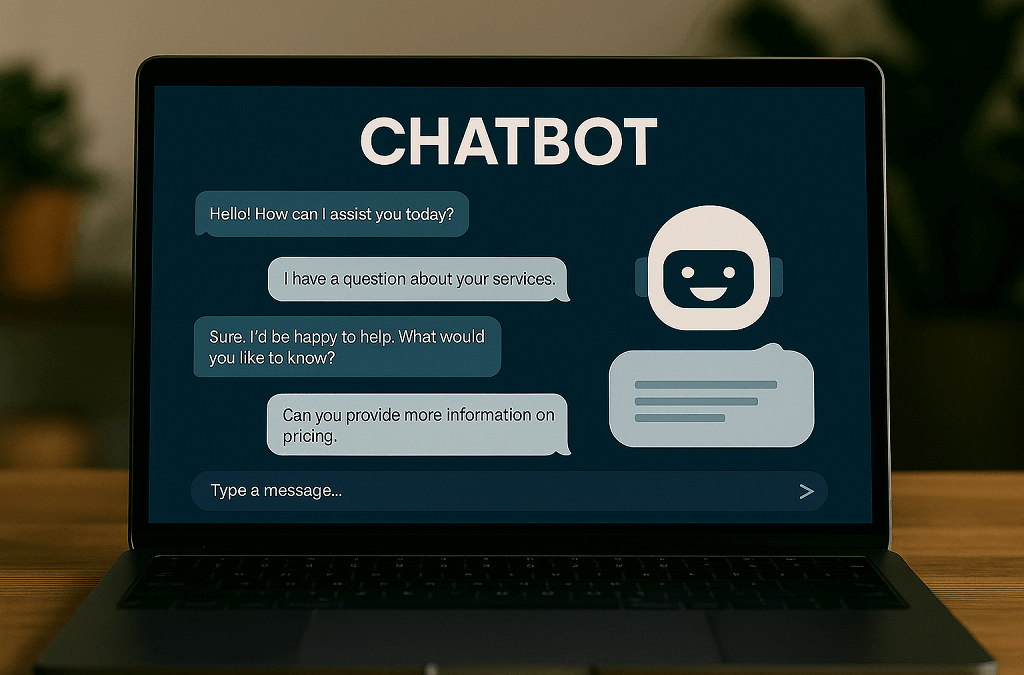
by Polina Yan
Chatbots aren’t a gimmick anymore. They’ve become the invisible workforce behind millions of daily conversations — answering customer questions, helping users place orders, even flirting with lonely fans in late-night chats. Businesses, creators, and solo entrepreneurs are all looking at the same thing: how to make your own chatbot that does the job exactly the way you need.
Some want a simple support bot that cuts down on emails. Others dream of an AI companion, a tutor, or even an NSFW chatbot that can generate income around the clock. The use cases are endless, but the building blocks are surprisingly similar.
This guide walks through seven clear steps anyone can follow, from sketching your idea to testing and scaling. And if you’re ready for a solution that’s branded, monetized, and fully under your control, Scrile AI can help you skip the limits of cookie-cutter tools and launch something truly yours.
Step 1 — Define Purpose and Use Case

Before you rush into tools, code, or fancy AI models, stop and answer the most important question: what do you actually want the bot to do? Without a clear purpose, you’ll end up with something that looks cool but fails to deliver. When you make your own chatbot, this clarity up front saves hours of development and avoids building features nobody needs.
Think about it in terms of roles. A chatbot can act as:
- Customer support agent — answering FAQs, guiding users through troubleshooting.
- Sales assistant — recommending products, upselling, tracking orders.
- Booking manager — handling appointments for a clinic, gym, or salon.
- AI companion — entertaining users, offering coaching, or even working as an adult chatbot for NSFW audiences.
- Productivity helper — organizing reminders, managing calendars, giving quick answers.
Each of these roles requires a different personality, knowledge base, and technical setup. An e-commerce FAQ bot has to integrate with product databases and answer shipping questions in seconds. A personal productivity bot needs access to calendars and natural dialogue skills. An NSFW chatbot must prioritize realism and privacy, while still giving the creator room to monetize it.
According to industry research, chatbots can handle around 70% of routine questions without human help. That statistic alone shows how much time and money you can save by defining your bot’s scope correctly.
So, before diving deeper, map out the use case. Write down your must-have features and your “nice-to-haves.” This first step transforms the vague idea of wanting to create own chatbot into a practical plan that can actually work.
Step 2 — Choose Your Approach: DIY or Development Service

After you’ve figured out what your bot should actually do, the next decision is pretty practical: do you want to build it yourself with a no-code tool, or have a team craft something that’s entirely yours? Both roads exist, but they lead to very different places.
The DIY chatbot route is what most people try first. Tools like Tidio or ChatBot.com give you a visual builder — drag, drop, connect a few blocks, and you’ve got a bot answering questions on your website within a day. It feels almost like playing with Lego. If you’re a small online shop or a freelancer just wanting a digital helper, this is often enough.
But the cracks appear once you start asking for more. Maybe you want the bot to push upsells, handle payments, or speak in a very specific tone. At that point, you realize you’re working inside someone else’s box. The platform decides what’s possible, not you.
That’s where a custom build comes in. A development service like Scrile AI doesn’t hand you a box — it helps you design your own. You’re not limited to a template; the team can connect the bot with your payment systems, add NSFW features if that’s your market, or give it a personality that feels like a real extension of your brand.
A small bakery might get by on a DIY chatbot that lists today’s specials. But if that bakery grows into a chain with delivery, loyalty programs, and custom upsell logic, a one-size-fits-all tool quickly feels like a toy. Sometimes speed is enough. Sometimes you need something that lasts.
Step 3 — Design the Conversation Flow
After you decide on the purpose and approach, the real work begins: shaping how your chatbot actually talks. If you want to make your own chatbot that doesn’t frustrate users, you need more than canned replies. A good bot has structure, but it also feels like a conversation.
At the core, every flow revolves around a few building blocks:
- Intents — the goals people bring into a chat. Someone might want to check delivery status, cancel a booking, or simply ask about pricing. Each of those needs its own path.
- Entities — the small details buried in the request. An order number, a date, or the name of a product all help the bot deliver a relevant answer instead of a generic one.
- Decision trees — the “choose your own adventure” backbone. Based on the user’s response, the bot knows which branch to follow next and where to end the conversation.
Designing these pieces is only half the job. The harder part is keeping the dialogue natural. People type in fragments, throw in emojis, or change their mind mid-sentence. If you’re serious about how to build a chatbot from scratch, your design has to account for that chaos. That means adding fallbacks (“Sorry, I didn’t catch that — do you mean tracking or returns?”) and giving the bot memory. If someone already entered their city, don’t ask for it again.
You can create flows visually in drag-and-drop builders like ChatBot.com, or go deeper with code using Node.js or Python. Either way, think of it like writing dialogue for a script: short lines, clear intent, and enough personality to keep people talking.
Step 4 — Select the Tech Stack and Integrations

Choosing the right engine for your chatbot is like picking the motor for a car. If you want to make your own chatbot that actually works under pressure, you have to match the tech to your goals. There are three common approaches:
- Rule-based bots follow scripts. They’re reliable for simple Q&A or yes/no trees but break down fast once users go off script.
- NLP-based bots (natural language processing) understand free text, handle slang, and feel more conversational. They’re ideal for support or companion chatbots.
- Hybrid bots combine both: rules for structure and NLP for flexibility. This is where most modern projects land.
But tech on its own isn’t enough. A useful bot plugs into the rest of your systems. Imagine connecting directly to:
- CRM tools like HubSpot or Salesforce, so the bot can pull customer history on the fly.
- Live chat systems, handing conversations to humans when things get too complex.
- Payment gateways such as Stripe or PayPal, letting customers buy products or renew subscriptions without leaving the chat window.
That’s also where Scrile AI stands out. As a development service, it doesn’t limit you to pre-set integrations. Their team can tie your bot into custom APIs, add monetization layers, or even enable NSFW features if that’s your niche. In other words, if you’ve been wondering how to create your own AI bot that doesn’t just chat but also earns, integrations are the piece that make it possible.
Step 5 — Train with Content and Data

Here’s the part where your chatbot starts to sound alive. Building the frame is one thing, but if you don’t feed it the right material, it ends up mumbling nonsense. Training is all about giving the bot access to the information it needs and shaping how it delivers that information.
Most people begin with the basics: an FAQ page, product descriptions, or existing support emails. That data becomes the first layer of knowledge. From there, you can pull in content scraped from your website, add documentation, or connect the bot to a live database so answers stay current.
Tone matters just as much as facts. If you want a friendly bot, write answers that feel conversational. If the brand is more formal, keep the language tight and professional. For an AI companion — or even an NSFW chatbot — tone is the entire product. Scripts, roleplay prompts, and carefully curated dialogue give it personality instead of leaving it flat.
Numbers prove why training pays off. Tidio’s research shows that its Lyro AI, once trained on FAQs, can handle about 70% of customer questions instantly. That’s fewer support tickets, less wasted time, and more satisfied users.
So when you’re thinking about how to create your own AI chatbot, don’t stop at building the shell. The content you put inside it — and the way you tune its voice — is what makes people come back to talk again.
Step 6 — Test, Refine, and Add Personality
You can’t just launch a bot and assume it works. If you want to make your own chatbot that people actually enjoy, you need to run it through real conversations, gather feedback, and polish the weak spots.
The easiest way is to recruit a handful of beta testers. Let them throw questions at the bot the same way a real customer or fan would. Don’t coach them, just watch how the dialogue plays out. Where do they get stuck? Which answers feel awkward? That’s where you focus your fixes.
Here’s a checklist that usually helps during refinement:
- Track failed conversations in detail: note when users type “talk to a human,” abandon the chat, or repeat the same question. These signals show where your bot isn’t clear enough.
- Expand intents with real wording: people rarely phrase things the way you expect. Add slang, shorthand, and typos to your training data so the bot understands natural input.
- Tighten answers with personality: avoid long robotic blocks of text. Instead, write short lines that sound like a person — even in corporate contexts.
- Test edge cases on purpose: ask the bot absurd or irrelevant things. See if it crashes or handles them gracefully with a polite fallback.
- Rotate testers over time: don’t rely on the same five people. Fresh users will always find new blind spots.
When you finally add personality — humor, empathy, or a brand-specific tone — the bot stops being a script and starts feeling like a real part of your business.
Step 7 — Launch, Monitor, and Scale

So, the bot is trained, polished, and has a voice. Now comes the part that feels both exciting and terrifying: pressing “go live.” When you make your own chatbot, the launch isn’t the end of the job — it’s just the beginning.
First, decide where it lives. A widget on your website is the classic choice, but plenty of projects start with Messenger, WhatsApp, or even a custom mobile app. Meet people where they already hang out.
After launch, don’t just let it run blind. Keep an eye on numbers that actually matter:
- Response time — how fast does it reply? Delays kill engagement.
- Satisfaction — are people leaving happy, or asking for a human right away?
- Conversions — does the bot actually help sell, book, or retain users?
Scaling is all about timing. Once the core works, add features slowly: voice input if your users like talking, image generation for creative bots, or multi-language support for global audiences.
The trick is simple — launch lean, learn from data, then grow. That’s how you keep the bot relevant long after the first wave of users shows up.
Why Scrile AI is the Best Way to Make Your Own Chatbot
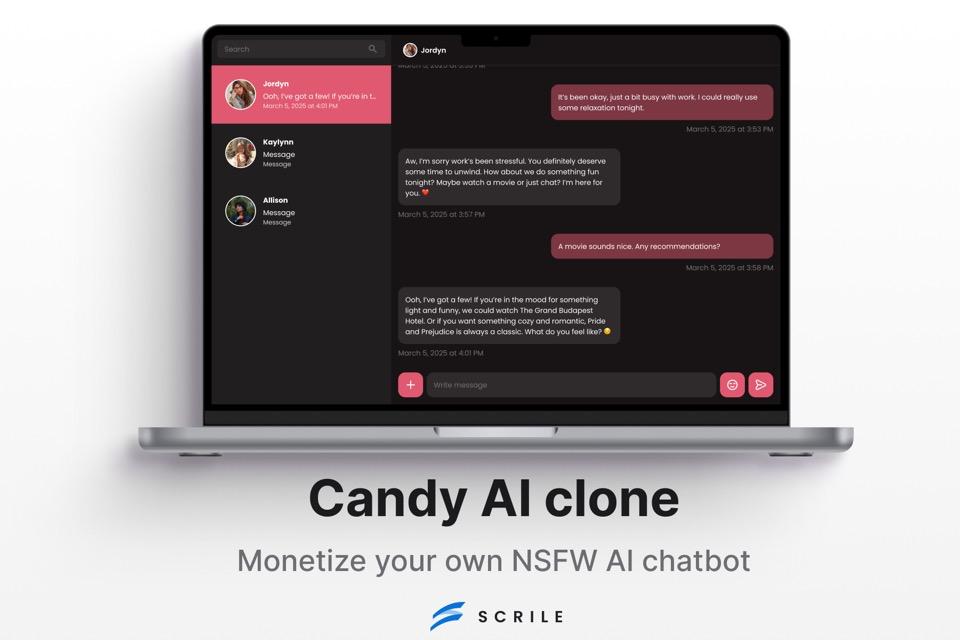
Each step in building a chatbot takes effort — shaping conversations, training data, testing, and scaling. Doing it alone with a DIY tool works for small projects, but if you want to make your own chatbot that feels polished, monetized, and truly yours, Scrile AI covers those bases in one package.
Here’s what sets it apart:
- White-label development — the chatbot lives under your brand with your domain and interface. No “powered by” tags or cookie-cutter layouts.
- Monetization built in — subscriptions, pay-per-chat, and token systems ready to deploy, so revenue streams are part of the design from day one.
- Support for NSFW and adult chatbots — something mainstream platforms avoid. Scrile AI enables projects in niches that others simply don’t allow.
- Zero commission model — unlike platforms that take a cut, Scrile AI leaves 100% of revenue and all customer data in your hands.
- Custom integrations — APIs, payment gateways, or unique workflows adapted to your business instead of forcing you to adapt to theirs.
Most chatbot builders stop at templates and drag-and-drop flows. Scrile AI acts more like a development partner, tailoring the solution to fit your vision. For creators, educators, startups, and even adult content entrepreneurs, it’s the difference between renting space on someone else’s system and owning the whole building.
With Scrile AI, you don’t just launch a chatbot — you launch a business asset that scales with you.
Conclusion
Making your own chatbot isn’t reserved for tech giants anymore — it’s something anyone can tackle by following a clear process. Seven steps are all it takes: define the purpose, pick your approach, design the flow, choose the tech, train with real content, test thoroughly, and scale with data. Each step builds on the last, and before long, you’ve got a bot that can answer questions, book appointments, or even entertain users.
DIY tools are a good launchpad, especially for small shops and side projects. But serious creators and businesses eventually need more control — branding, monetization, integrations, and features that free templates can’t offer.
That’s exactly where Scrile AI shines. Explore their service and contact the Scrile AI team to turn your idea into a chatbot that grows with your business, not against it.
Polina Yan is a Technical Writer and Product Marketing Manager, specializing in helping creators launch personalized content monetization platforms. With over five years of experience writing and promoting content, Polina covers topics such as content monetization, social media strategies, digital marketing, and online business in adult industry. Her work empowers online entrepreneurs and creators to navigate the digital world with confidence and achieve their goals.

by Polina Yan
The online coaching market is estimated at $7.3 billion in 2025 and is expected to surge to nearly $26 billion by 2032, making it one of the fastest-growing sectors in the digital economy. People now turn to digital coaches for everything: fitness plans, business growth, career changes, language learning, even adult guidance.
If you’ve been thinking about how to start an online coaching business, the conditions are finally lined up. Remote work made video calls second nature. Payment systems are simple enough that clients from any country can subscribe in minutes. And audiences are more willing than ever to invest in expertise that feels personal.
In this article, we’ll map out the essentials: how to choose a niche, set up the business side, build a digital presence, deliver value online, and scale when the first clients come in. By the end, you’ll know what it takes to launch in 2025.
Why Coaching Thrives in 2025

Look around and it’s clear: people are spending more money on guidance than ever. Market research puts coaching in the multi-billion range, and the curve is still climbing. The interesting part is how wide the field has become. Ten years ago, most people thought of coaching as either business or fitness. Now, it stretches across dozens of professions, with real clients paying for one-on-one time online.
Some of the strongest niches right now are:
- Tutors and teachers supporting students after school or preparing for exams.
- Wellness and nutrition consultants building structured meal and lifestyle plans.
- Astrology and spiritual mentors giving personalized readings and advice.
- Life coaches helping with career moves or building confidence.
- Fitness trainers running workouts over video with tracking and accountability.
For anyone asking how to start online coaching, this diversity is the real gift. You don’t have to chase the same crowded categories as everyone else. The market rewards specialists, people who bring expertise and package it in a way that feels personal and practical.
Defining Your Niche and Value

Specialization isn’t about boxing yourself in — it’s about making it clear why someone should hire you instead of scrolling past. The online coaching space is crowded, and the easiest way to stand out is by carving a narrow lane that highlights both your skills and your personality.
Start by asking yourself two questions: What do I know well enough to teach or guide? and Who actually needs this right now? The sweet spot is where those answers overlap. For example, a certified nutritionist might narrow down to busy professionals who struggle with meal planning. A lawyer might focus on helping small businesses draft their first contracts. A yoga teacher might turn her weekend classes into a stress-relief program for remote workers.
Testing demand doesn’t require big budgets. Run a poll in your existing network, offer a short free session, or post sample tips on social media and see who responds. If the engagement is there, you’ve got proof that people care about the problem you’re solving.
Value comes from clarity. When a potential client lands on your page, they should immediately know what problem you solve and how you deliver it. Broad promises like “I’ll help you live your best life” don’t move the needle. Clear, specific offers — “I’ll help first-time managers lead their teams with confidence” — are what turn curiosity into paying clients. Your niche is the hook, and your value is how you prove it.
Setting Up Your Coaching Business Basics

Before you go live with your first client, it helps to treat your coaching idea like a real business from day one. That means putting some structure in place — nothing fancy, just enough to protect you and make payments smooth. Anyone exploring how to start a coaching business online will find these basics make the difference between a side hustle and something sustainable.
Things worth setting up early:
- Registering a business entity and opening a dedicated bank account so client payments don’t mix with your personal finances, and you can present invoices under an official name.
- Sorting out taxes and basic bookkeeping from the start so you know what percentage of your income to set aside each month instead of scrambling when deadlines arrive.
- Drafting simple coaching agreements or contracts that outline session length, cancellation rules, payment terms, and confidentiality. Clients respect clarity, and it saves headaches later.
Pricing models that work for coaches:
- Hourly sessions are straightforward but make scaling harder since your income is tied to time.
- Packages or bundles of sessions give stability, reduce cancellations, and create momentum for your clients.
- Subscriptions or retainers turn coaching into recurring revenue, rewarding consistency and freeing you from constantly chasing new clients.
These basics don’t take long to set up but will give your coaching work a professional backbone from the beginning.
Building Your Digital Presence

Once the paperwork is done, the real challenge starts: showing up online in a way that feels trustworthy. Anyone asking how to start an online coaching business needs more than a LinkedIn profile or a random Instagram account. You need a digital footprint that tells potential clients, “this is someone worth paying.”
That usually begins with a website. Keep it simple but professional — a homepage that explains what you do, a clear call to book a session, and a way to collect emails. From there, layer in branding: colors, photos, tone of voice. Consistency across your site and socials makes you look reliable, even if you’re just starting out.
Content is what drives people into your orbit. Blogs, short videos, or free webinars act as funnels, giving value upfront and pulling curious followers toward your paid offers. An email list turns those casual followers into a community you can reach without worrying about algorithm changes.
Tools worth focusing on:
- A clean website with booking and payment options.
- Social channels where your audience already hangs out, not where you feel you “should” be.
- Regular content — posts, videos, or podcasts — that teach something useful and hint at your paid services.
- An email list, even if it’s small, because subscribers are more likely to convert than casual followers.
Why Brand Matters More Than Reach
It’s easy to get obsessed with follower counts, but numbers don’t pay bills. A coach with 500 loyal subscribers and a clear brand can earn more than someone with 50,000 unengaged followers. People don’t buy coaching because you’re popular; they buy because you look credible, consistent, and aligned with what they need.
Choosing the Right Tech Stack

You don’t need to reinvent the wheel to coach online. At the simplest level, plenty of people run sessions on Zoom or Google Meet, take payments through PayPal, and schedule with Calendly. That setup can work fine for your first handful of clients. But if your goal is how to become an online business coach with a long-term brand, you’ll quickly notice the gaps.
The essentials are always the same:
- Video software that supports stable one-to-one or group sessions.
- Scheduling tools so clients can book without back-and-forth emails.
- Payment processing that works globally, including cards, wallets, or even subscriptions.
- Chat and messaging to keep communication alive between sessions.
SaaS platforms bundle many of these features, and they’re tempting because they let you start quickly. The trade-off is lack of control — you’re tied to their branding, their fees, and their feature set. A personal website stitched together with third-party tools gives you more flexibility but can feel clunky for clients if the systems don’t integrate smoothly.
Custom builds sit at the other end of the spectrum. They take longer to set up, but they give you complete ownership: your name on the interface, your payment flow, your rules. For some coaches, that level of control is what makes the difference between a side gig and a business that grows steadily year after year. The tech is there — the choice is about how far you want to take it.
Delivering Coaching Online
Once you’ve got clients through the door, delivery is where you prove your value. Online coaching isn’t one-size-fits-all — the best format depends on your style and what your audience expects. Some coaches thrive in one-on-one sessions, giving clients deep personal attention. Others prefer group programs, which create peer support and let you scale faster. Many blend both with hybrid models, combining live coaching with recorded lessons or worksheets.
Retention is just as important as the first sale. Clients stay when they feel supported and see progress. That requires structure, not just casual chats.
Engagement tactics that work well:
- Clear session roadmaps so clients know what’s coming next.
- Homework or follow-up tasks to keep progress moving between calls.
- Recorded replays for people who miss live sessions.
- Chat groups for accountability and peer interaction.
- Regular check-ins outside scheduled sessions, even short messages.
Clients who feel momentum are less likely to cancel. When they can see tangible outcomes — a new skill, a fitness milestone, a confident career shift — they tell others. Word-of-mouth is still one of the strongest growth drivers in coaching, and that starts with how you deliver.
Scaling Beyond the First Clients
The early months often feel like freelancing: hustling for clients, juggling calls, sending invoices. But once you’ve proven your model works, it’s time to think bigger. Learning how to start an online coaching business doesn’t end with your first paying clients — it’s about creating something that runs beyond you.
The next step is building community. A group space where members interact gives more value than one-on-one calls alone. Partnerships help too: teaming up with other coaches, influencers, or local businesses expands your reach without doubling your workload.
Revenue expansion comes naturally once the base is solid. Some coaches add subscription tiers, others launch digital products like courses or workbooks. A few move into retreats or high-ticket programs. Each step pushes you further from being a solo freelancer toward owning a coaching business that scales.
And it all ties back to that first question: how to start an online coaching business in a way that grows with you.
Scrile Meet: Built for Coaching Growth
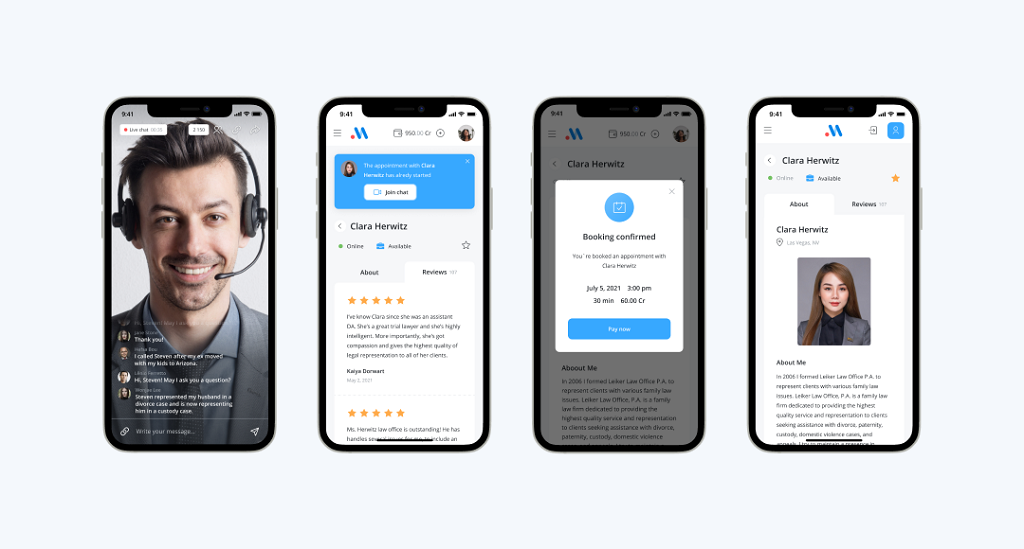
There comes a point where juggling Zoom, PayPal, and scheduling links starts to feel like patchwork. That setup works for a few clients, but once you begin to grow, the cracks show: missed bookings, clients confused about payment, and branding that feels like it belongs to someone else. This is where coaches discover that off-the-shelf tools are built for convenience, not for scale. If you want your coaching business to look professional, stay organized, and actually earn like a business, you need infrastructure that bends around your needs — not the other way around.
That’s where Scrile Meet comes in. Unlike pre-packaged platforms that force you into their templates and take a cut of your income, Scrile Meet is a custom development service. It’s designed to give coaches ownership, flexibility, and the chance to grow their work into a recognizable brand.
What Scrile Meet brings to the table:
- Full white-label branding with custom design so your clients only see your logo, your colors, and your name — no third-party banners reminding them they’re renting someone else’s system.
- Live video features for both one-on-one sessions and group calls, letting you choose the right delivery style without bolting on separate tools.
- Integrated booking and scheduling that syncs with your calendar, making it easy for clients to choose a time and reducing the endless back-and-forth emails.
- Direct payments wired straight to your account without middlemen fees, giving you predictable cash flow and full control over pricing.
- Flexible monetization models, from monthly subscriptions to pay-per-view access and premium content libraries, so you can experiment with different revenue streams under one roof.
- An admin dashboard with reporting and analytics that tracks revenue, client activity, and engagement — so you’re not guessing which part of your business works.
Why Scrile Meet Helps Scale Coaching
For anyone serious about how to start an online coaching business and move beyond freelancing, Scrile Meet acts like a foundation, not a patch. You’re not stuck with clumsy workarounds or losing money to transaction cuts. Instead, you’re building a branded coaching hub that’s flexible enough to grow and strong enough to last. This is the difference between coaching as a side hustle and coaching as a sustainable company.
Conclusion
Starting an online coaching journey in 2025 isn’t about luck — it’s about making deliberate choices. Pick a niche you can own, set up the business foundations early, build a digital presence that feels professional, and deliver coaching in formats that keep clients engaged. From there, scaling comes naturally through communities, partnerships, and additional revenue streams.
The one factor that separates short-lived projects from lasting businesses is the infrastructure behind them. Free tools are fine to test ideas, but sustainable coaching requires systems built for growth.
If you’ve been asking yourself how to start an online coaching business, the path is clear: strategy plus the right technology. Explore Scrile Meet service today to shape your coaching into a branded, scalable business without relying on clunky third-party platforms. It’s the step that transforms coaching from a side project into a sustainable company.
Polina Yan is a Technical Writer and Product Marketing Manager, specializing in helping creators launch personalized content monetization platforms. With over five years of experience writing and promoting content, Polina covers topics such as content monetization, social media strategies, digital marketing, and online business in adult industry. Her work empowers online entrepreneurs and creators to navigate the digital world with confidence and achieve their goals.

by Polina Yan
Membership models are everywhere — not because they’re trendy, but because they work. From fitness instructors to NSFW creators, from niche communities to business consultants, more people are building paid spaces for people who want more than just free content.
When you create a membership site, you’re making a space people can return to. Not a one-time download or a throwaway link. A portal that grows with your audience and pays you monthly. The numbers back it up. According to Statista, In 2024, subscription-based businesses generated over $275 billion globally, and the projections for 2025 are even higher.
Still, building one from scratch? It’s not something you figure out by chance. It takes planning, the right setup, and a structure that fits how you deliver content — whether that’s live coaching, gated videos, private chat groups, or bonus downloads.
This guide is your starting point. You’ll see what makes a membership site actually work, what tools you can use, and how to avoid the usual mistakes. And if you’re not the plug-and-play type? There’s a smarter way to build your own platform — one that fits your business, not the other way around.
What Is a Membership Site Really?

It’s not just about hiding content behind a login. When you create a membership site, you’re building an experience that feels private, valuable, and worth paying for — not just once, but every month.
At its core, a membership site is a gated space online where people pay to access something they can’t get anywhere else. This could be premium content, early releases, live sessions, a community, or even direct access to you. The value isn’t just the material — it’s the relationship.
Real-World Use Cases
Let’s break it down with real examples:
- A coaching hub where business or wellness coaches upload videos, worksheets, and host private Q&A sessions.
- An OnlyFans-style content wall where adult creators or performers post exclusive content for paying fans only.
- A course platform where each module unlocks weekly, keeping learners engaged and progressing.
These setups go way beyond a blog with a paywall or a Substack newsletter. A membership site is interactive, often including tools like community forums, private messaging, booking calendars, and digital downloads. It becomes a two-way space where members feel like they belong — and stick around longer because of it.
This is also where the phrase exclusive content meaning really comes to life. It’s not just about access — it’s about access with privilege. Your audience feels like insiders. They get things no one else does, and that exclusivity builds loyalty.
How It’s Different from the Usual Content Models
A membership site isn’t just another blog filled with ads. You’re not launching a newsletter or tossing videos on YouTube hoping for clicks. This is a direct channel — built with intent. You decide the pricing, the structure, and how people experience your content.
Even compared to platforms like Patreon, building your own membership site gives full control — over branding, data, and features. There’s no competition for visibility, no reliance on someone else’s algorithm. It’s your space, your terms, your vision.
That’s the point of building something real. Something you own.
Core Ingredients of a Successful Membership Site

You can’t just toss up a login form and call it a day. If you want to create a membership site that people actually pay for — and keep paying for — it needs to run smooth, feel premium, and keep users coming back. That means handling the tech behind the scenes just as carefully as the content upfront.
What You Can’t Skip If You Want It to Work
Start with the entry point: your user registration and access control. You need more than just usernames and passwords. You need logic — free trial setups, timed access, custom roles. Maybe someone gets five days free, then bumps into a paywall. Maybe another gets access to one module at a time. All of that has to be baked in from day one.
Then there’s your content delivery engine. Doesn’t matter if it’s video tutorials, zip downloads, or livestreams — people expect it to be fast, responsive, and mobile-ready. Hosting matters. Format matters. Compression, playback, even file naming — all of it plays into how users experience your content.
And of course, recurring payment logic. When you build a membership website, you’re not just selling once — you’re managing renewals, declines, reactivations, upgrades, downgrades. You need automated billing systems, retry flows, and payment reminders built right in.
Want to offer tiered memberships? You’d better define what each level actually unlocks. Does “Gold” mean group coaching calls? Does “Platinum” include 1-on-1 sessions or bonus content? These levels shouldn’t just exist — they should be felt by your users.
Finally — engagement. It’s the piece most creators overlook. Without tools for interaction, a membership site turns into little more than a content dump. Think about forums, private messaging, reactions, or even push notifications for new uploads. When people can connect — with you and with each other — the entire experience becomes stickier, more valuable. That’s half the battle already won.
And yes, how to build a membership website in 2025 means building for mobile, flexibility, and scale. That’s not just about features. It’s about making sure your users stay longer than a free trial — because what you’ve built actually feels like it’s built for them.
Core Ingredients of a Successful Membership Site
If you want to create a membership site that people actually stick around for, you need more than just a paywall and a promise. The backbone of a solid membership experience is tech that works, content that delivers, and systems that keep users coming back. This isn’t about stacking features. It’s about building the essentials right.
Start with the gate. You’ll need secure user registration and access control — a login system that segments content by tier, tracks usage, and lets your users feel like they’re unlocking something made for them. Free trials? Guest passes? That’s where the experience begins.
Then, the core engine: content delivery. This can mean exclusive videos, PDFs, recorded webinars, or gated live sessions. Whatever your thing is — adult education, fitness classes, dating advice, or premium clips — your delivery system needs to work smoothly across all devices, from laptops to phones.
Engagement Tools Matter More Than You Think
What separates an average site from one people talk about? Interaction. Build in chat, private messages, discussion boards, or even push notifications. A membership site without a heartbeat becomes a ghost town. Create spaces for conversation, feedback, and community bonding. These tools aren’t just extras — they’re how your audience forms habits around your content.
Now add the money layer. A modern site needs recurring billing infrastructure. Think: subscription plans, one-time upsells, coupon logic, or custom trial periods. Users should be able to upgrade, downgrade, or cancel easily — with full transparency. You can’t afford billing errors or confusing checkout flows.
On top of that, you’ll want tiered subscriptions. Give your audience real reasons to pay more — bonus content, early access, private live streams, or VIP support. Don’t just price high for the sake of it. Give each tier a clear identity and outcome.
If you’re wondering how to build a membership website that doesn’t fall apart after a few months, this is the blueprint. You need the tools that support growth — not just launch.
Above all, remember this: to create a membership site that performs, you’re not stacking software. You’re building a product. And every product starts with the basics — done right. No fluff. No filler. Just functional, user-centered structure that scales with your audience.
Plan Before You Build: Goals, Monetization, Audience

Before you create a membership site, stop and think. Who are you building for? What do they need — and more importantly, what would they actually pay for? If your answer is “everyone” or “more content,” you’re setting yourself up for silence. Real success starts by narrowing in.
The best membership sites are built for someone, not everyone. A yoga coach who offers weekly video flows, a finance blogger with archived PDFs, an adult content creator with monthly drops — each of these speaks to a defined niche. And each charges for something tangible: convenience, exclusivity, or speed.
Popular Monetization Models
Once you’ve defined your audience, it’s time to get real about the money. Here are the most effective models people use when they create a membership site:
- Freemium: Free content to attract, premium content to retain
- One-time access: Single payments for digital downloads
- Recurring tiers: Monthly subscriptions with feature upgrades
- Pay-per-view: Great for adult or coaching content
- Tip jars or microtransactions: Add-ons, not the main offer
A common mistake when figuring out how to make a membership website is assuming your audience will just pay because you’re posting. The truth? People pay when you consistently deliver value, and the path to that value needs to be dead simple.
Define Your Core Offer
“Premium content” is too vague. Lock in exactly what subscribers get. That might include:
- A weekly video drop
- Monthly live sessions
- Private community access
- Archive of past content
- Early access or exclusive media
Get specific. If you’re offering a fitness plan, describe the format. If it’s educational, outline the curriculum. People want to know what their money buys.
When you create a membership site that’s actually worth joining, it comes down to two things: your offer and your audience. Miss either one, and your fancy platform won’t matter.
Choosing the Right Tech: Website Builders, SaaS, or Custom?

You’re ready to create a membership site. But before you dive in, there’s one big question to answer: what tools are you going to use?
This isn’t just a technical decision — it’s a strategic one. The tech you choose will shape your user experience, limit (or empower) your growth, and define how flexible your site really is. Let’s look at the three paths most people take.
Option 1: Website Builders (Wix, WordPress)
If you’re testing the waters or starting small, a traditional website builder might feel like the easiest move. Tools like Wix and WordPress offer plugins like MemberPress or Restrict Content Pro that add basic paywall features.
Pros:
- Cheap upfront
- Easy to set up
- Lots of templates
Cons:
- Limited customization
- Reliant on plugins for complex logic
- Security and scalability concerns
Website builders are a decent option if you want to create a membership website free or just explore the model. But they’ll quickly show their limits when your audience grows or if you need advanced tools.
Option 2: SaaS Membership Platforms
Platforms like Mighty Networks, Thinkific, or Kajabi give you all-in-one solutions: content hosting, subscriptions, basic analytics. These are great for creators who want something that “just works.”
Pros:
- Streamlined tools for subscriptions and content delivery
- Hosting and support included
- Community features built-in
Cons:
- You don’t control the backend
- Monthly fees that grow with usage
- Can’t deeply customize user flows
If you’re learning how to start a membership site, SaaS tools can get you moving fast. But when you need to stand out or scale up, these boxed platforms start to feel like a cage.
Option 3: Full Custom Development
This is the most flexible and ownership-friendly route. You hire a development team to build your membership site from scratch — exactly how you want it. No templates, no platform limits, no forced features.
Pros:
- Complete control over design, features, and business model
- Easily scale as your audience and content library grows
- Advanced monetization options (custom checkout, bundles, trials)
- Seamless integration with internal tools or CRMs
Cons:
- Higher upfront cost than DIY or SaaS
- Requires more planning and technical collaboration
- Longer timeline to launch
Not every business needs this level of control — but for creators and teams who outgrow pre-made platforms, it’s a serious advantage. Let’s now look at the ready-made SaaS platforms that offer quicker setups and pre-packaged features.
Popular Membership Site Platforms in 2025
Creating a membership site used to mean hiring a full dev team right away — but in 2025, there are dozens of SaaS tools and WordPress-based plugins that promise to help you get started in a few clicks. While these membership site platforms don’t offer full flexibility, they can work for creators and businesses who want something fast and pre-built. Below, we break down five of the most popular tools, each with its own strengths, quirks, and ideal use cases.
1. Mighty Networks
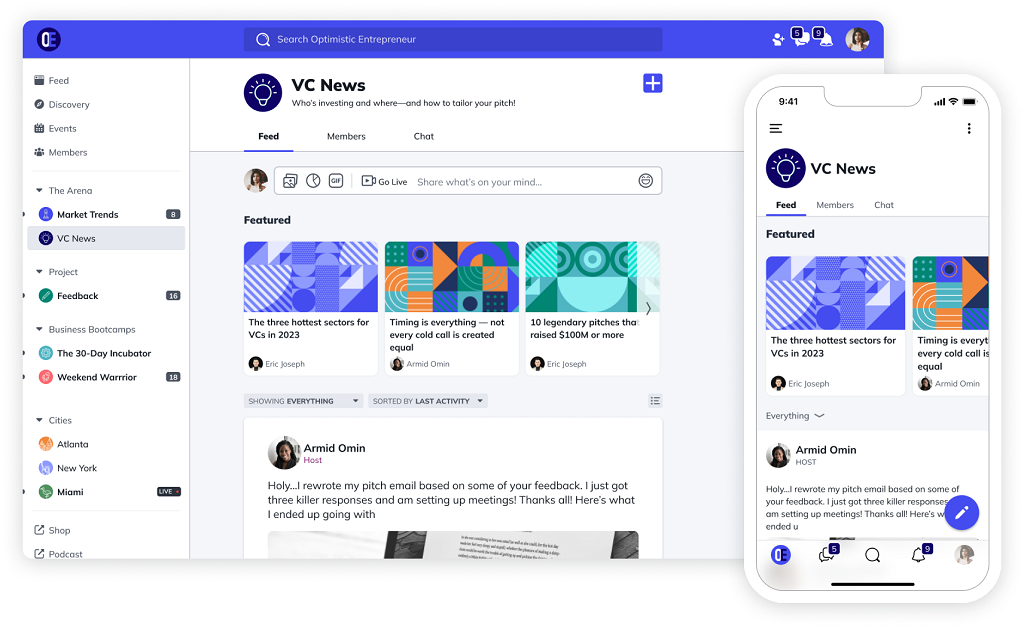
Mighty Networks positions itself as a community-first platform where the membership experience is built around interaction. It’s built to help creators foster direct engagement — and it shows. You get native chat, community posts, event management, and even course delivery in one place.
Best for: Creators and coaches who want an all-in-one community with memberships baked in.
Pros:
- Strong community features (chat, events, spaces)
- Mobile apps included
- Allows bundling courses and memberships
- Modern interface that feels like a social network
Cons:
- Limited control over payments and data
- Design options are quite rigid
- Not ideal for very large-scale content libraries
If you want to create a membership site centered around engagement and group interaction, Mighty is a serious contender — just don’t expect deep design freedom.
2. Kajabi
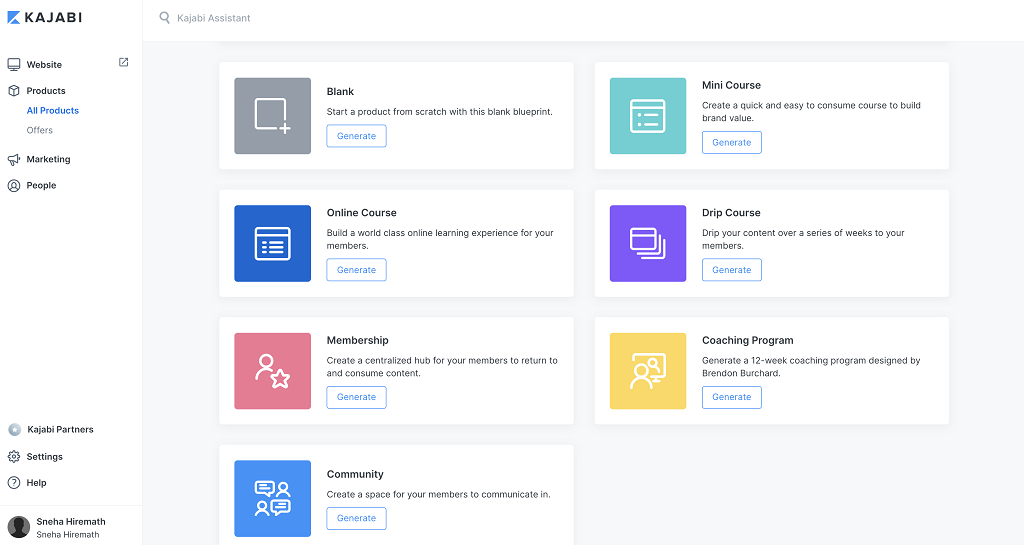
Kajabi is a heavyweight in the digital product world. It’s an all-in-one SaaS that lets you sell courses, coaching, and memberships from a single dashboard. Kajabi isn’t cheap, but it’s packed with features like pipelines, email marketing, and automations — aimed at scaling solo businesses.
Best for: Online educators, consultants, or course creators ready to monetize at scale.
Pros:
- Excellent funnels and automations
- Email and CRM built-in
- Easy drag-and-drop website builder
- Clean UX for members
Cons:
- Expensive, especially as your list grows
- Limited visual customization
- Not ideal if you need complex access rules
For those looking to create a membership site that doubles as a marketing machine, Kajabi has most tools under one roof — but the price tag matches the ambition.
3. LearnWorlds

LearnWorlds is one of the most comprehensive learning-focused membership site platforms out there. While it’s designed primarily for online courses, it includes everything you need to create a membership site layered with subscriptions, certifications, and interactive video content. Unlike many “drag-and-drop” tools, LearnWorlds gives you a slightly steeper learning curve — but also more flexibility in course structuring.
Best for: Educators and training organizations who prioritize interactivity and credentialed learning.
Pros:
- Advanced course structuring with drip, quizzes, certifications
- Built-in assessment and SCORM support
- Website builder includes page templates and popups
- Integrates with Zapier, Zoom, Mailchimp, and more
Cons:
- Interface is functional but not always intuitive
- Takes time to set up complex course structures
- Transaction fees on lower-tier plans
LearnWorlds works especially well if your membership website development is focused on professional learning environments or corporate training portals. If you’ve ever asked how to create a membership website for online schools or certification-based coaching, this tool delivers depth where others stop at surface-level features.
4. Thinkific

Thinkific is another education-first platform, with a clean UI and a great balance between usability and control. Unlike Kajabi, it doesn’t bundle email and CRM features — but for some, that’s a plus. You won’t pay for bloated tools you don’t use. You can design a clean learning experience and add memberships, subscriptions, and communities through paid add-ons.
Best for: Coaches and teachers looking for a streamlined, affordable solution without complex marketing tools.
Pros:
- Free plan available (limited features, but good for testing)
- Solid course builder with video, PDF, and quizzes
- Memberships and communities available as upgrades
- No transaction fees on paid plans
Cons:
- Fewer built-in marketing tools than Kajabi
- Limited automation unless you integrate third-party tools
- Custom design options require coding knowledge
Thinkific is ideal if you want to create a membership site that feels clean, distraction-free, and focused on content delivery. You won’t get the all-in-one flair — but for many creators, simplicity wins.
5. MemberPress

MemberPress is a WordPress plugin that turns your existing website into a powerful membership website builder. It’s a favorite among bloggers, educators, and small publishers who want to monetize content without leaving the WordPress ecosystem. With MemberPress, you get granular access control, subscription tiers, content dripping, and tight integration with existing plugins like WooCommerce or LearnDash.
Best for: WordPress users who want total control over content and integrations.
Pros:
- Native to WordPress — works with most existing themes and plugins
- Flexible rules for paywalled content (pages, posts, categories)
- Integrates with Stripe, PayPal, and Authorize.net
- Supports coupons, drip schedules, and LMS plugins
Cons:
- Requires comfort with WordPress backend
- You’ll need to handle hosting, security, and backups yourself
- Limited support compared to all-in-one platforms
If you’re already using WordPress, MemberPress can be the shortest path to launching gated content. It’s a membership website builder that feels more like a toolkit — flexible and robust, but not entirely beginner-friendly. It’s especially effective for publishers who need granular control and are comfortable managing plugins and site infrastructure.
Custom Development = More Control: Why It’s Worth It
The promise of no-code builders and SaaS tools is speed — but what you gain in convenience, you often lose in control. Most of these platforms are built around the average user. That means fixed templates, limited logic, and a monetization model that benefits the tool, not you.
Try building something unique — like a hybrid content-on-demand and coaching portal — and you’ll hit a wall. You’re stuck with their rules. No backend logic to tweak. No fast feature rollouts unless their roadmap says so.
Worse, you don’t really own the thing. Your subscribers, your payment data, your user content — all of it flows through systems you can’t fully access or export. And when the platform updates, breaks, or sunsets a feature? You’re stuck.
That’s where custom development earns its weight.
Building from scratch — especially with a team that listens — means full control. You’re the one mapping user flow, setting access rules, and defining what’s paid and how. The post-purchase experience? That’s yours to shape too. Trials, tipping, content unlocks — every detail fits the audience you actually have, not some generic version imagined by a SaaS template.
It’s also about scale. What works with 50 users might not work with 5,000. Platforms don’t always grow well. Custom code does — when it’s built right.
In short: if your idea doesn’t fit in a box, don’t try to squeeze it into one. Build the thing the way it deserves to exist. In the next section, we’ll show how.
Build Your Membership Site with Scrile Connect

Not every creator fits inside a SaaS box. Templates can be helpful — until they limit your growth. You start by tweaking colors, then hit a wall when trying to change how subscriptions work, or when adding new content formats. That’s where full-service development becomes the smarter route.
Scrile Connect isn’t another drag-and-drop builder. It’s a development team that works with you to create exactly what your membership site needs — without making you adapt to someone else’s rules.
You Define the Membership Logic
At the core of any serious membership site is access control. Who sees what, and when? Scrile Connect lets you define that from scratch — including things like:
- Time-based unlocks (e.g., day 1 = intro, day 7 = bonus pack)
- Custom trial periods and coupon systems
- Granular tier access (e.g., one post available to all, another to paid fans only)
You don’t have to settle for whatever system your platform gives you. You decide how your content is accessed — and how users move between subscription levels.
Monetization, Your Way
Every creator’s revenue model is different. Some want simple monthly subscriptions. Others prefer tip jars, bundles, or even NFT integration. Scrile Connect gives you room to shape your monetization logic instead of forcing it into a prebuilt format.
Here’s what that might include:
- Pay-per-view for premium content drops
- Recurring subscriptions with flexible pricing
- One-time offers or lifetime access plans
- Integration with adult-friendly payment providers if needed
Again, the goal isn’t to choose from a dropdown. It’s to make sure your business model works the way you planned it.
Community & Content, Customized
Most SaaS platforms give you forums, chat, or video — rarely all three. And when they do, they’re often limited in layout or features. Scrile Connect doesn’t force you to choose. If your model needs livestreams, private group messaging, or embedded training modules — it can be built. You’re not limited to a standard feature list.
Some of the real-world builds created with Scrile Connect include:
- A gated NSFW creator platform with real-time tipping, group chats, and private video calls.
- A wellness hub that combines a members-only course library, scheduling for 1:1 coaching, and downloadable nutrition plans.
- A knowledge-sharing portal that uses tiered memberships to unlock templates, community forums, and member-uploaded content.
The common thread? These aren’t repurposed templates. They’re purpose-built systems that match the client’s audience and goals.
Why Custom Often Wins
Let’s be blunt: SaaS platforms are fast. But they also come with limits — branding restrictions, third-party data storage, and fixed workflows that can’t scale when your business model grows. If you’re serious about long-term control, custom development shifts the power back into your hands.
Here’s what you gain with a tailored approach like Scrile Connect:
- Branding control — every screen matches your visual identity, not theirs
- Scalable backend — no need to migrate when your user base expands
- Data ownership — your content, your audience, your rules
- Compliance options — including secure hosting for adult or regulated content
This isn’t about bells and whistles. It’s about building the right foundation from the start — so you don’t have to rebuild later.
And yes, going custom means a bigger upfront investment. But it also means you’re not paying forever for features you can’t change. For many creators, consultants, and educators, that’s the smarter long-term move.
Final Checklist Before You Launch
You’ve come this far — the portal’s built, the content is in place, and the payment system is ready. But don’t hit publish just yet. A smooth launch isn’t about switching on the site. It’s about testing, rehearsing, and controlling the rollout. Here’s how to avoid common last-minute disasters and make sure your membership site starts strong.
Test Everything — Like a Real User
Don’t just rely on your team to poke around. Recruit 3–5 people who weren’t involved in the build and ask them to test:
- Login and registration flows (multiple devices, multiple browsers)
- Payment process, including discount codes, upgrades, and cancellations
- Content access — make sure tiered content locks/unlocks correctly
- Emails and alerts — test onboarding sequences, confirmation emails, password resets
Catch bugs now, not after 50 users are locked out or charged twice.
Dry Run the Monetization Engine
You’d be surprised how many launches fail because a payment gateway wasn’t linked properly. Run test transactions through Stripe, PayPal, or whatever provider you’re using. Cancel a subscription. Trigger a refund. Try edge cases: expired cards, failed charges, currency switching. Clean up the flow before you start accepting real money.
Set the Stage for Controlled Growth
It’s tempting to go wide from day one, but a phased launch gives you time to adapt:
- Start with beta access for your inner circle or biggest fans
- Use invite-only access to build FOMO and control onboarding
- Schedule content releases so the platform doesn’t feel empty
And above all, make sure someone is on standby. No launch is perfect — but being prepared means fewer surprises and a better first impression.
Now, with everything tested and tuned, you’re ready for the final step: go live and build momentum.
Conclusion: Own the Platform, Own the Revenue
The shift toward gated content isn’t slowing down — it’s evolving. From creators and coaches to niche experts and educators, more people are choosing to create a membership site to turn what they know into what they earn. It’s not just about putting content behind a paywall. It’s about designing an experience where your audience feels connected, supported, and willing to pay for continued access.
And here’s the part most newcomers miss: real ownership matters. When you control the platform, you control the data. You shape the brand. You decide what features are added — not some third-party company that sees you as just another customer.
Using generic site builders or boxed SaaS tools might get you moving faster. But long term? The lack of flexibility, limited branding, and revenue-share models catch up. Personalization starts to feel impossible. Your growth gets capped.
If you’re serious about building something that reflects your vision — not someone else’s template — then it’s time to build it your way.
Reach out to the team at Scrile Connect and start designing a custom membership site that’s yours from top to bottom. Not rented. Not limited. Built for scale — and built for you.
Polina Yan is a Technical Writer and Product Marketing Manager, specializing in helping creators launch personalized content monetization platforms. With over five years of experience writing and promoting content, Polina covers topics such as content monetization, social media strategies, digital marketing, and online business in adult industry. Her work empowers online entrepreneurs and creators to navigate the digital world with confidence and achieve their goals.

by Polina Yan
If you run anything that schedules people—haircuts, yoga sessions, tutoring slots, therapy calls, repair visits, church meetings, coaching sessions—you already know the calendar rules the day. It decides who shows up, who pays, and how much time is left to actually work. Tools like Setmore make that easier, which is why so many small and mid-sized teams start there. It does the basics well: online booking pages, reminders, payments, and staff calendars. But as businesses grow, they start hunting for Setmore alternatives because operations don’t all follow the same script.
Some teams need intake forms and recurring sessions. Others want group bookings, custom branding, deposits up front, marketplace-style scheduling, or deeper integration with internal dashboards. That’s where the differences really show.
This article looks at what Setmore does right, where it falls short, and how other scheduling tools compare on features, pricing, and control. We’ll walk through several competitors that fit different use cases, then look at what happens when switching tools still doesn’t solve the deeper workflow issues—and why some teams eventually decide to build something custom instead of hopping between apps.
What Setmore Does Well (and Where It Struggles)

Setmore is a familiar name in scheduling—whether you’re a tutor, therapist, salon, or repair technician. You set services, staff hours, let clients pick slots, and you get reminders. It plugs into Stripe, PayPal or Square so you can take payments when clients book. The dashboard shows calendars for each staff member, and there’s support for video appointments too. According to the Setmore pricing page, they offer a Free plan for up to 4 users at $0/month, and a Pro plan at $5/user/month when billed annually (or $12/user/month billed monthly).
That said, many switch because they hit walls. Here are the friction points:
- Branding feels generic. Even with paid tiers, the booking page branding is minimal and still looks like everyone else’s.
- Payment logic is okay but not highly flexible. You may need workarounds for advanced payment setups such as deposits, split payments or custom revenue flows.
- Heavy dependence on external integrations. When you require deep workflow automation or custom databases, you end up layering multiple tools.
- Backend control is shallow. Reporting exists, but if you want full dataset exports, custom workflows or complete control over the database—you’ll run into constraints.
When you line these up, you start comparing Setmore vs other tools—asking whether you stay, switch, or build from scratch.
Top Setmore Alternatives
Not every booking tool solves the same problem. Some focus on simple scheduling links for one-person businesses; others are built for full-scale teams that need routing, intake forms, payments, or multiple service providers. When people look for Setmore alternatives, they’re usually not “shopping for a new app” — they’re trying to match software to how their business actually works.
Below is a breakdown of five options worth considering, each used by different types of service providers.
Calendly (use case: meetings & sales teams)

Best for: Teams that book calls across time zones and rely heavily on integrations.
Pros:
- Connects to Google/Outlook calendars instantly
- Routing forms help distribute calls across a team
- Polished booking links for sales, demos, onboarding
Cons:
- Many features locked behind paid tiers (workflows, SMS, routing)
- Limited branding control unless you’re on higher plans
Why pick it: Strong for organizations needing automated scheduling flows, especially when comparing Setmore vs Calendly for sales teams rather than appointment-based services.
Acuity Scheduling (use case: coaching, wellness, sessions with forms)

Best for: Coaches, therapists, and fitness trainers who need complex session logic.
Pros:
- Intake forms + HIPAA-ready options (on higher plans)
- Packages, subscriptions, and recurring sessions
- Strong payment options for paid appointments
Cons:
- More setup work than Setmore
- UI feels utilitarian rather than polished
Why pick it: Great when comparing Setmore vs Acuity for session-based businesses that need forms, subscriptions, or repeat clients.
YouCanBookMe (use case: simple scheduling + email customization)

Best for: Teachers, consultants, small teams booking a lot of short calls.
Pros:
- Strong timezone handling
- Very customizable email workflows (reminders, follow-ups)
- Simple scheduling flow, easy onboarding
Cons:
- Limited advanced automation
- Not the best choice for multi-provider businesses
Why pick it: Works well for small organizations, especially those researching YouCanBookMe alternatives to upgrade later to something more robust.
Koalendar (use case: clean booking pages & low-cost upgrades)
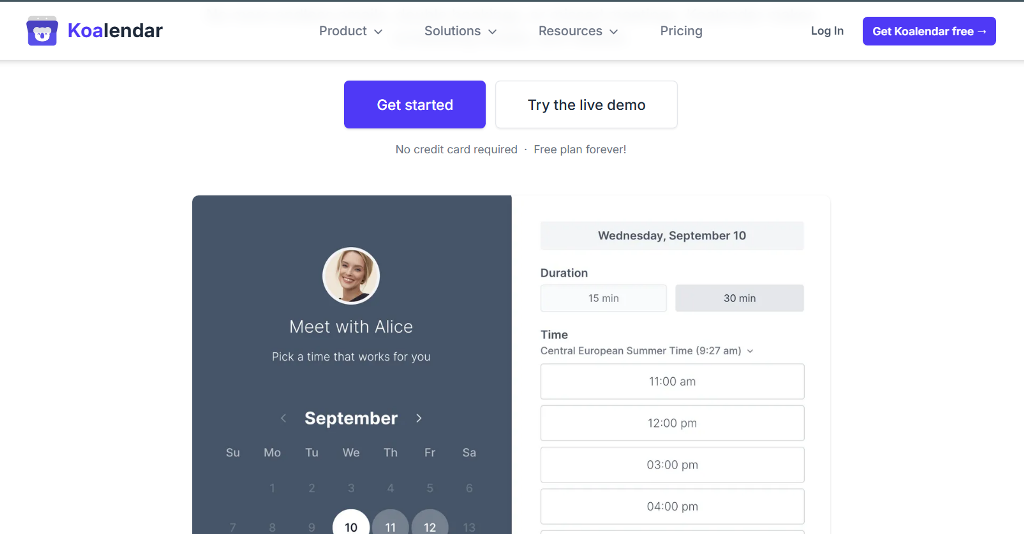
Best for: Solo creators, consultants, and small operations that want a polished booking page without a steep learning curve.
Pros:
- Simple setup, minimal onboarding
- Unlimited bookings on paid plans
- Polished public booking pages that don’t look like generic templates
Cons:
- Fewer advanced workflows for large teams
- Limited monetization features compared to Acuity or SimplyBook.me
Why pick it: A practical choice if you want something visually cleaner than Setmore but still lightweight and affordable.
SimplyBook.me (use case: beauty, wellness, local services)
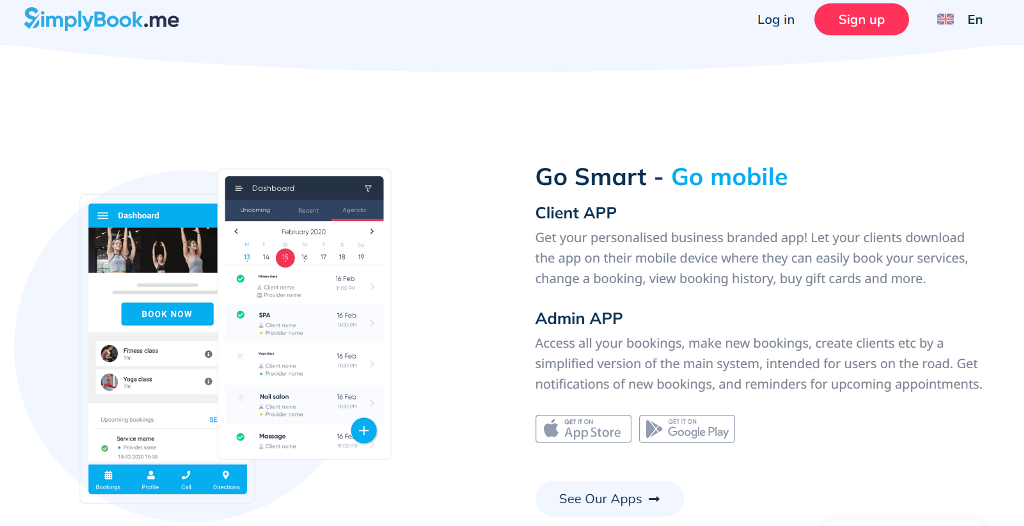
Best for: Salons, spas, trainers, clinics—anyone offering physical appointments tied to inventory and staff roles.
Pros:
- Memberships, coupons, classes, POS, gift cards
- Client app + customer login options
- Good for multi-location or inventory-based businesses
Cons:
- Interface has more menus and takes time to learn
- Feels like overkill if you only need basic scheduling
Why pick it: Ideal for service businesses that need promotional tools and staff roles, not just appointment slots.
When Switching Isn’t Enough
Most teams start comparing tools because a feature is missing—maybe they need intake forms, deposits, or better reminders. But there’s a stage where switching apps doesn’t fix the deeper issue. It happens when scheduling stops being a calendar link and becomes part of how the business actually runs.
A few situations make this obvious:
- A company operates across multiple locations and needs shared calendars, regional staff access, and internal dashboards for managers.
- A platform or mobile app wants booking built directly inside its product, not hosted on a third-party page with someone else’s branding.
- A marketplace needs provider-specific pricing, payouts, and service categories that standard scheduling tools weren’t designed to handle.
- A tutoring network charges per class, tracks attendance, and issues recurring invoices—all from the same system.
When teams hit that stage, the problems shift from missing features to missing control. You’re limited by APIs that only sync a few data fields, templates that won’t match your branding, and integrations that start stacking like patched wiring. Data stays scattered across tools, and reporting never gives a full picture of how clients move through the business.
This is where people look beyond simple Setmore alternatives and start thinking about something shaped around their own workflows. The goal becomes owning the scheduling experience end-to-end, from booking and payments to user roles and analytics, rather than bolting tools together and hoping nothing breaks on a busy week.
Build Your Own Scheduling System with Scrile Connect
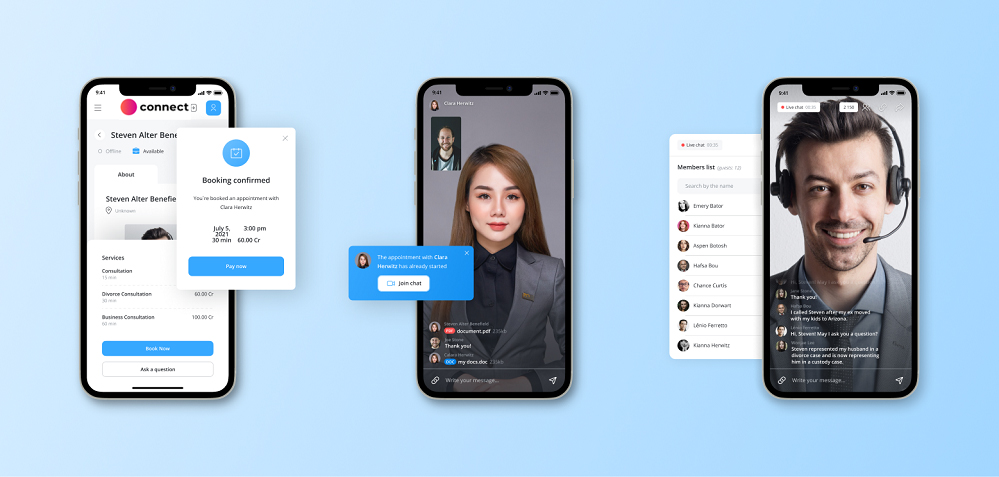
Once scheduling becomes part of how a business operates—not just something attached to it—building a tailored system starts to make sense. Scrile Connect focuses on custom development, meaning you’re not subscribing to another SaaS tool or adapting to someone else’s templates. You’re shaping a platform around your existing workflow, branding, payment structure, and internal roles.
Instead of using a public booking link hosted on a third-party domain, everything lives under your own name. Calendars, sign-ups, reminders, payments, service types, staff roles—every element is configurable. And if you outgrow a feature later, you don’t wait for a vendor’s roadmap; you just extend the system.
Businesses typically choose this route when they want booking to feel integrated, not bolted on. A few common scenarios:
- Internal booking dashboards for large teams with different permissions and reporting access
- White-label client portals for agencies or platforms that onboard multiple companies
- Paid consultation systems with deposits, session credits, or subscriptions
- Multi-vendor marketplaces where each provider sets their own pricing and availability
- Customer portals where booking ties directly into accounts, messaging, and billing
These are the situations where switching between Setmore alternatives isn’t enough, because the product itself depends on scheduling rather than simply using it.
A custom system doesn’t just manage appointments. It can connect to CRMs, payment gateways, learning platforms, chat tools, or staff dashboards—whatever the workflow demands. Scrile Connect can build scheduling into a larger ecosystem: onboarding, messaging, file sharing, recurring payments, even community features. Appointments become one part of a full product, not a standalone utility.
The goal isn’t to replace familiar tools; it’s to build something that grows as your business grows, without fighting software limits along the way.
Conclusion
No single scheduling tool works for every team. Freelancers want something quick to set up. Wellness coaches need sessions, subscriptions, and forms. Larger organizations look for routing, permissions, or revenue tracking. That’s why there are so many Setmore alternatives, each built around a different idea of how booking should work.
The real choice isn’t about which tool “wins.” It’s about how much control you need—your own branding, your own data, and the flexibility to shape scheduling around your business instead of adapting your business to software. For many teams, switching apps is enough. For others, scheduling becomes part of the product itself, and that’s when custom development starts to make sense.
If you’re building something that needs to grow without hitting feature ceilings, explore custom solutions with Scrile Connect and create a booking experience built around your workflow from day one.
Polina Yan is a Technical Writer and Product Marketing Manager, specializing in helping creators launch personalized content monetization platforms. With over five years of experience writing and promoting content, Polina covers topics such as content monetization, social media strategies, digital marketing, and online business in adult industry. Her work empowers online entrepreneurs and creators to navigate the digital world with confidence and achieve their goals.
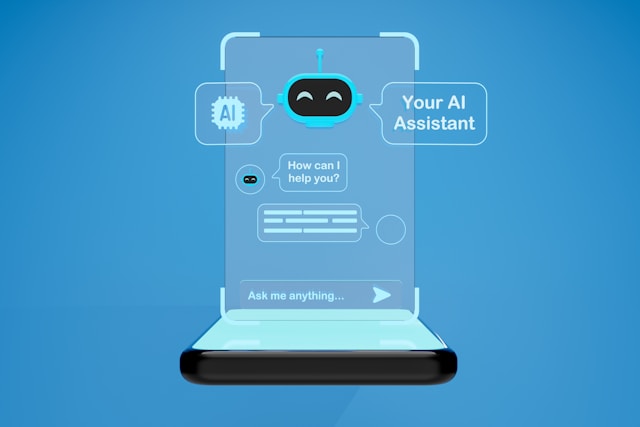
by Polina Yan
There’s a limit to how many tabs we can juggle, how many tasks we can track in our heads, and how many calendar invites we can answer before something drops. Between back-to-back meetings, inbox chaos, and constant notifications, many people — from solo entrepreneurs to mid-sized teams — are burning time just trying to stay organized. It’s no surprise that interest in the AI personal assistant app category has exploded. These aren’t just smart to-do lists anymore. The best tools in 2025 actually think ahead — auto-scheduling your day, handling email threads, flagging potential conflicts, and learning from your habits over time.
While the tech itself is impressive, what makes these assistants so compelling is how specific they’ve become. There are AI tools built just for freelancers managing client work, apps designed for overwhelmed team leads, and others crafted for creators who want to streamline production without losing their voice.
And with large language models becoming more accessible, these assistants are no longer locked behind enterprise software. Anyone with a browser and a need for structure can try one — or build one.
In this article, we’ll walk through five of the most effective AI personal assistants available in 2025. We’ll cover what they do best, how they handle real-world tasks, and how you can use them to free up your time and focus on the work that actually matters.
Quick Snapshot: 5 Best AI Personal Assistants
| App | Best For | Standout Abilities | Where It Falls Short | Ideal Team Size |
|---|
| Motion | Dynamic schedules & shifting priorities | Real-time auto-scheduling, focus blocks, deadline-aware replanning | Limited email help; interface feels “calendar-first” to some | Solo → SMB teams |
| Clara | Email scheduling & client coordination | Natural-language email replies, timezone handling, hands-free rescheduling | Narrow scope (emails/meetings); relies on inbox workflows | Execs, client-facing roles |
| Reclaim.ai | Protecting focus time & habits | Smart time-blocking for routines, adaptive priorities, shared visibility | Not an email assistant; requires calendar buy-in from team | Individuals → small teams |
| Trevor AI | Minimalist task→calendar flow | Drag-and-drop time-blocking, simple UI, priority-based suggestions | Fewer “enterprise” features; lean reporting | Freelancers, creators, consultants |
| Taskade AI | Creative planning & real-time collab | AI outlines/mind maps, templates, multi-user editing, NL commands | Less specialized in scheduling/email | Creative teams, remote squads |
Why AI Personal Assistants Are Evolving So Fast
Five years ago, most digital assistants were glorified reminder apps — they could ping you at 9 AM, maybe reschedule a meeting, and that was about it. Fast forward to 2025, and we’re looking at a completely different category of tools. Today’s AI personal assistants aren’t just reactive. They’re proactive, adaptive, and increasingly personalized.
This leap comes from a few major shifts in the tech behind the scenes. First, the rise of powerful large language models like GPT-4, Claude, and others has allowed assistants to hold natural conversations, understand nuance, and summarize complex threads of information. The best ones don’t just listen — they learn. They start to understand your priorities, your work rhythms, and even how you write.
Second, modern AI task assistant systems are built on smarter automation stacks. They connect with your calendar, Slack, project tools, email, and files — and then take action based on real-time data. It’s not just about scheduling anymore. It’s about doing things for you.
And finally, privacy and personalization have improved. The most advanced AI personal assistant app can now run in secure environments, giving users more control over what’s stored, shared, or deleted.
If you’re wondering how to use AI as a personal assistant, the answer is increasingly: however you want. The tools are catching up to your needs — and in many cases, anticipating them.
5 Best AI Personal Assistant Apps in 2025
There’s no shortage of tools claiming to make your life easier, but not all of them actually do anything for you. The apps below aren’t just organized interfaces — they function like real assistants. They schedule your meetings, sort your day, and anticipate your next move. Whether you’re running a solo business or managing a remote team, these five picks represent the strongest options on the market right now.
Feature Matrix (What Each App Actually Does)
| Capability | Motion | Clara | Reclaim.ai | Trevor AI | Taskade AI |
|---|
| AI auto-scheduling | ✅ | ➖ | ✅ | ✅ | ➖ |
| Email handling / scheduling by email | ➖ | ✅ | ➖ | ➖ | ➖ |
| Task management | ✅ | ➖ | ✅ (habits/routines) | ✅ | ✅ |
| Deep-work / focus blocks | ✅ | ➖ | ✅ | ✅ | ➖ |
| Team collaboration (live docs/boards) | ➖ | ➖ | ✅ (calendar visibility) | ➖ | ✅ |
| Templates / AI brainstorming | ➖ | ➖ | ➖ | ➖ | ✅ |
| Calendar integrations (Google/Outlook) | ✅ | ✅ | ✅ | ✅ (Google) | ➖ |
| Mobile apps | ✅ | ✅ | ✅ | ✅ | ✅ |
| Typical pricing model | Subscription | Per-seat / usage | Subscription | Freemium / subscription | Freemium / subscription |
Legend: ✅ = native strength · ➖ = limited/indirect
Motion — Real-Time Planning That Adjusts Around You
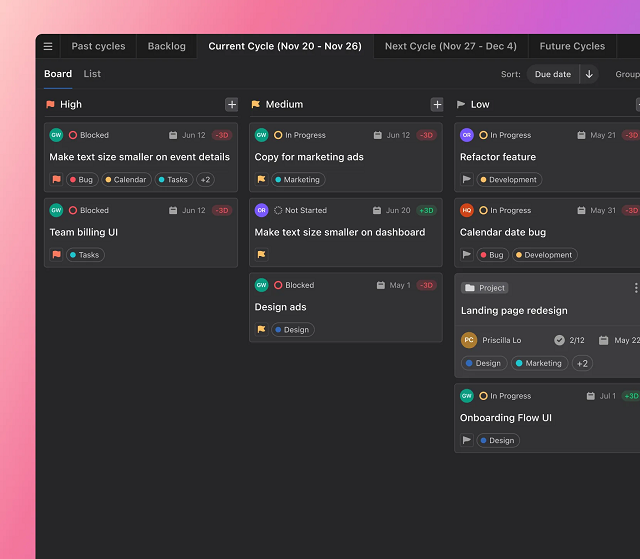
If your calendar is a mess, your tasks are scattered across apps, and you’re constantly re-planning your day, Motion steps in like a calm, invisible assistant. This tool blends calendar management, task planning, and prioritization — then uses AI to automate the rest.
What sets Motion apart is that it doesn’t just remind you what to do. It actively reschedules tasks based on shifting deadlines, meeting changes, and how long you actually need to finish something.
Key features include:
- AI-powered daily auto-scheduling
- Integration with Google and Outlook calendars
- Real-time updates when meetings shift or cancel
- Prioritization based on deadlines and task weight
- Smart focus time blocks for deep work
It’s built for people who need to defend their schedule without constantly managing it — remote workers, team leads, or solo professionals with unpredictable days.
Instead of building a routine around a tool, Motion builds your routine around you. It keeps things moving without the mental load.
For anyone looking to gain back hours without hiring a human assistant, Motion is easily one of the best AI personal assistant app options available in 2025.
Clara — Email Scheduling Without the Awkward Ping-Pong
Clara is an AI personal assistant app built for one thing: handling meeting coordination over email, so you never have to go back and forth again. But what sets it apart is its human touch. Instead of sending generic booking links, Clara actually reads the conversation, interprets tone, and replies like a real assistant.
It integrates directly with your calendar and jumps in when you CC it on an email. From there, it handles the rest — confirming time zones, checking availability, following up, and even rescheduling if needed. The emails are clean, professional, and surprisingly human.
Key features include:
- Email-based meeting scheduling with natural language
- Full calendar integration with Google and Outlook
- Support for multi-participant and recurring meetings
- Customizable tone and communication style
- Hands-free rescheduling and reminders
Clara is ideal for executives, client-facing professionals, or anyone who wants to skip the hassle of manual coordination — without sacrificing personal touch.
It may not be the flashiest tool, but as far as personal assistant software goes, it’s one of the smoothest experiences on the market in 2025.
Reclaim.ai — Protect Your Focus Without Losing Flexibility
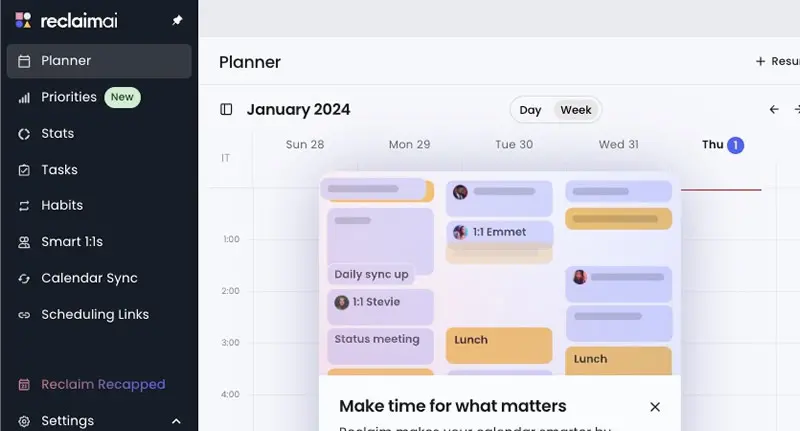
If you constantly feel like your calendar is working against you, Reclaim.ai might be the smartest fix. This tool acts like an invisible layer over your schedule — automatically blocking time for deep work, habits, and recurring tasks, while still adjusting when meetings come up. It’s designed for people who want more control over their day without micro-managing every hour.
The real value of Reclaim lies in how well it protects your priorities. You set goals for how often you want to work out, catch up on email, or prep for meetings — and Reclaim makes it happen by finding space for it in your calendar. When new meetings appear, it shifts things intelligently so you don’t lose momentum.
Key features include:
- AI time blocking for habits, tasks, and routines
- Automatic calendar syncing across platforms
- Real-time adjustments based on new events or conflicts
- Priority settings that align with personal and team goals
- Shared calendar visibility for teams
Reclaim.ai is one of the best AI assistants for work because it doesn’t just help you get things done — it helps you make space for what matters most. Especially valuable for remote workers, creatives, or anyone balancing project work and meetings.
Trevor AI — Calendar Meets To-Do List With Zero Clutter
Trevor is a hidden gem that marries a robust to-do list to scheduling in real-time, and it’s an excellent choice for someone who wants complete control of their day — but no unnecessary burden. Where more weighty productivity systems are heavy, Trevor is light and simple: it puts your items directly onto your calendar and uses artificial intelligence to inform you of when you should be doing what.
Where it shines is simplicity. You create your task list, choose some of the options, and Trevor provides you time blocks that actually work. No distractions, no unnecessary menus. It’s the kind of assistant that helps you create habits rather than reacting to chaos.
Key features include:
- Task-to-calendar syncing with drag-and-drop ease
- AI suggestions based on priority and availability
- Simple interface designed for solo users
- Integrates with Google Calendar
- Real-time time-blocking that updates as you go
Trevor AI is perfect for freelancers, consultants, and solo creators who want to manage time better without overloading on features. It’s clean, fast, and surprisingly good at keeping you on track.
Among the more focused tools on the names of AI assistants lists in 2025, Trevor earns its place for doing exactly what it promises — and doing it well.
Taskade AI — A Creative Workspace Powered by Collaboration
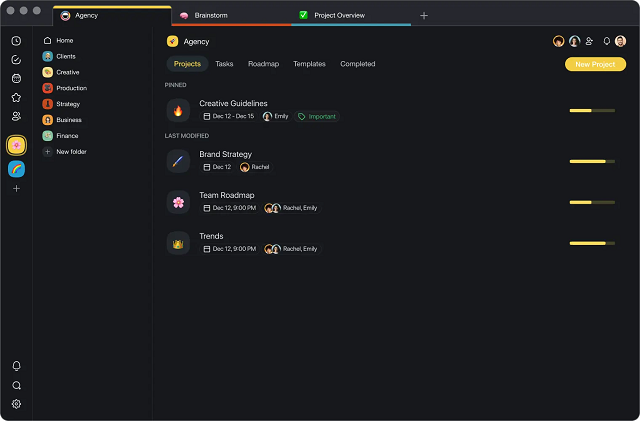
Taskade stands out in the manner in which it achieves the balance of productivity and creativity. It is not a helper that lets you do, but lets you think, co-create, and collaborate in projects in real-time. Designed specifically for remote teams, virtual creatives, and solo operators who don many hats, Taskade uses AI to automatically outline, structure ideas, and task manage in a single versatile workspace.
Unlike traditional assistants that focus only on scheduling or email, Taskade leans into structure and brainstorming. Whether you’re writing a content plan, mapping out a product launch, or just managing your weekly goals, it gives you smart suggestions and automates your repetitive workflows.
Key features include:
- AI-generated task lists, outlines, and mind maps
- Collaborative editing across devices
- Templates for marketing, content, and planning
- Natural language commands for creating or reformatting tasks
- Real-time sync with team members
If you want an assistant that feels more like a creative partner than a scheduler, Taskade AI delivers. It’s versatile, visual, and surprisingly intuitive.
As more tools flood the list of AI assistants in 2025, Taskade keeps its edge by balancing functionality with a playful, flexible interface — and that’s what makes it stick.
“Pick-By-Use-Case” Decision Guide
| Your Situation | Pick This | Why |
|---|
| Day changes hourly; need automatic replans | Motion | Rebuilds your day around shifting meetings/deadlines |
| Endless back-and-forth to book meetings | Clara | Handles email threads like a human assistant |
| Need to protect habits & deep work | Reclaim.ai | Locks important routines without sacrificing flexibility |
| Want the lightest task→time workflow | Trevor AI | Zero-clutter time-blocking that actually sticks |
| Creative planning with real-time collaboration | Taskade AI | AI outlines + shared workspaces keep teams moving |
Scrile AI: Building a Custom AI Assistant for Your Business

Even the smartest tools on the market come with limits. Off-the-shelf solutions often force you to adapt your workflow to their features — not the other way around. You’re stuck with pre-set templates, limited branding options, and feature caps that eventually slow you down. If you’ve ever tried scaling a service around an app you don’t control, you know how frustrating that can be.
Scrile AI offers an alternative: a way to build your own AI assistant from the ground up. Not another tool — a fully customized platform tailored to your business, your users, and your growth strategy. Whether you need a productivity-focused AI, a chatbot with personality, or something completely unique, Scrile AI gives you full control over how it works and how it looks.
What Scrile AI can deliver:
- Custom-branded UI/UX to match your voice and audience
- Safe-for-work or NSFW conversational logic
- Built-in monetization: subscriptions, tipping, PPV
- Admin dashboard with analytics, CRM, and user controls
Use cases include:
- Adult creators launching AI companions (Candy AI-style)
- Influencers building interactive AI personas
- Businesses needing scheduling, customer support, or sales automation agents
The result isn’t just an app — it’s a business. One that doesn’t rely on third-party rules, algorithms, or app store restrictions. If you’re serious about building the best personal AI assistant for your brand or audience, Scrile AI helps you own every part of it — from backend logic to user experience.
Off-the-Shelf Assistants vs. a Custom One (Scrile AI)
| Option | Ownership & Branding | Flexibility | Monetization | Data Control | Good Fit For |
|---|
| Off-the-shelf apps (Motion/Clara/Reclaim/Trevor/Taskade) | Vendor-controlled; light branding | Feature set fixed to roadmap | Usually none (tooling only) | Provider policies apply | Individuals & teams adopting standard workflows |
| Scrile AI (Custom Assistant) | 100% yours (UI/UX, domain, persona) | Build exactly what you need: scheduling, inbox, CRM hooks, voice/NSFW modes, etc. | Built-in: subscriptions, tips, PPV | Full control (deployment & retention) | Brands/creators/companies needing a owned, scalable assistant |
SoftService x Scrile AI: we can help you design, build, and launch a custom AI assistant that matches your stack (calendar, email, project tools), your brand voice, and your revenue model—without vendor lock-in.
Conclusion
AI personal assistants in 2025 aren’t just helpful — they’re becoming essential. Whether you’re managing a packed schedule, coordinating a remote team, or building your own AI product, the right tool can save hours and reduce stress. Off-the-shelf apps are a great starting point, but if you need full control, customization, and revenue potential, building your own assistant makes more sense.
Curious what that could look like? Get in touch with the Scrile AI team to explore how you can launch your own custom AI personal assistant app — exactly how you want it.
Polina Yan is a Technical Writer and Product Marketing Manager, specializing in helping creators launch personalized content monetization platforms. With over five years of experience writing and promoting content, Polina covers topics such as content monetization, social media strategies, digital marketing, and online business in adult industry. Her work empowers online entrepreneurs and creators to navigate the digital world with confidence and achieve their goals.

by Polina Yan
Social media isn’t just a marketing instrument these days but a necessity for brands, agencies, and businesses looking to stay relevant and competitive. Yet, maintaining active, compelling presence on various platforms requires skill, time, and constant adaptation to algorithm adjustments and trending trends. For most businesses, it’s an operational burden, leading to missed opportunities and fragmented branding.
Having in-house social media managing personnel costs, as professional planners, creators, and analyzers must be hired. On the other hand, managing multiple client accounts as an agency has the effect of diluting the available staff. That is why businesses and agencies are finding more and more that they are searching for outsourced solutions that provide full-service social media management without the need to build everything from scratch.
The Shift Towards Scalable Social Media Solutions
Instead of struggling to keep up with daily posting, engagement tracking, and advertising optimization, companies are now adopting turnkey solutions that allow them to scale without the growing pains. Businesses want to expand their service offerings, while agencies want to increase revenue without adding operational complexity.
That’s where white label social media management services come in—providing an efficient, cost-effective way to offer high-quality social media services under your own brand. Whether you’re an agency looking to resell social media solutions or a business seeking automation and optimization, these services allow for seamless scalability.
In this article, we’ll explore the best platforms, posting software, and automation solutions that make managing social media easier. We’ll also discuss custom development options for businesses that want to create their own white label social media platform instead of relying on third-party tools.
What Are White Label Social Media Management Services?

White label social media management services allow businesses and agencies to offer social media marketing solutions under their own brand without having to build the infrastructure or hire a dedicated team. They are offered by third-party platforms that perform all the work, from the planning and dispatch of the messages through engagement monitoring and analysis to the management of the ads, but the reseller markets it as their own service.
White label solutions offer the simple solution for businesses, influencers, and marketing agencies to expand without the high cost associated with in-house development. Companies need not spend months building a custom social media software solution on their own. They may easily implement a proven solution created and focus on building their client base.
Key Benefits of White Label Social Media Services
One of the biggest advantages of using white label social media software is that it eliminates the technical and operational burden of managing multiple client accounts. Businesses can offer professional social media services without worrying about software development, platform maintenance, or hiring additional staff.
- No In-House Development Needed. No need to make any investments in automating software, software programmers, or social media planners. The provider does all the work.
- Scales Quicker and Client Acquisition. Agencies are able to include services in their portfolio immediately, boosting their revenue without the added work.
- Branded Experience End to End. The clients are provided with the fully branded experience, thus making the agency look as though it designed the platform internally.
Who Benefits from White Label Social Media Management Software?
These services are ideal for:
- Digital marketing agencies looking to offer social media solutions without hiring additional staff.
- Freelancers and consultants who want to provide fully managed social media services to their clients.
- Influencers and content creators seeking a way to monetize their expertise by offering social media management as a service.
- Large businesses and enterprises that want to outsource their social media marketing while maintaining full branding control.
With the right white label social media platform, businesses can deliver high-quality social media services, improve client retention, and grow their revenue—all without the hassle of running an in-house team.
Key Features to Look for in White Label Social Media Management Software

Choosing the right white label social media management software is critical for agencies and businesses looking to provide a seamless, branded social media experience for their clients. The best platforms go beyond just scheduling posts—they offer automation, collaboration, analytics, and security features that make managing multiple accounts efficient and scalable.
Social Media Scheduling & Automation
A strong scheduling and automation system is at the heart of any white label social media platform. Bulk posting, automated scheduling, and AI-driven optimization ensure content is published at the best times for engagement without manual intervention. Advanced tools allow agencies to plan weeks or months’ worth of content in advance, streamlining workflows.
Content Curation & Creation Tools
Social media success relies on high-quality, engaging content. Many platforms include pre-built design templates, AI-generated captions, and customizable graphics to help teams create posts quickly. An integrated library ensures consistency in branding with less human time spent creating the content.
Collaboration & Approval Workflows
Where agencies work with more than one client, collaboration across several users is a requirement. White label social media platform must therefore incorporate multi-user permission, approval workflows, and role-based permission to aid in maintaining the brand consistency. Clients should be able to review and approve content before it goes live, making communication more efficient.
Analytics & Reporting
Data-informed decision-making paves the path to social media triumph. A top-notch platform provides white-label branded reports, which facilitate agencies in offering bespoke performance metrics with their own branding. Engagement rates, audience growth, click-through rates, and measurement via ROI enable businesses to optimize their strategies and demonstrate concrete results to clients.
Client Dashboard & Branding Options
The best white label social media software allows for full dashboard customization to reflect an agency’s branding. This means custom logos, domain integration, and personalized interfaces, ensuring a seamless client experience that strengthens brand authority.
Security & Compliance
Having several clients’ accounts requires stringent security controls. Complying with GDPR, role-based access, and encrypted storage ensures that sensitive data is kept safely but in line with industry standards.
Selecting the right white label social media management platform ensures that agencies can scale efficiently, provide high-value services, and maintain full brand control without the need for in-house development.
Top White Label Social Media Management Services & Posting Tools
The right white label social media management services make all the difference for businesses and agencies that need to streamline content creation, creation, planning, and analysis under their own brand. From the many different white label social media software, the optimum selection would be one that has scalability, automation, brand-ability, and affordability as its criteria. Below are the reviews of some of the major platforms that offer white label social media posting and management solutions.
SocialPilot – Scalable Scheduling and Automation
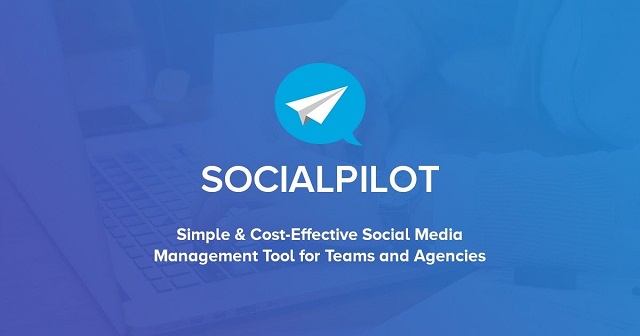
SocialPilot is a comprehensive white label social media platform designed for agencies and businesses managing multiple client accounts. It offers bulk scheduling, AI-driven automation, and custom reporting, making it an efficient tool for handling high-volume posting.
- Key Features:
- Multi-account management for social media teams.
- Automated scheduling to optimize post timing.
- Custom-branded reports for client analytics.
- Best for: Agencies that need affordable, scalable automation for posting and client reporting.
Sendible – White Label Dashboards & Team Collaboration
Sendible provides a fully branded white label social media app for agencies wanting a professional, customizable dashboard. The platform allows teams to collaborate on content creation, assign roles, and manage approval workflows before publishing.
- Key Features:
- Custom domain support for a branded experience.
- Client approval workflows to streamline content publishing.
- Advanced engagement tracking with built-in analytics.
- Best for: Agencies looking for a client-friendly white label social media management platform with strong collaboration tools.
PromoRepublic – AI-Powered Content Generation & Brand Management
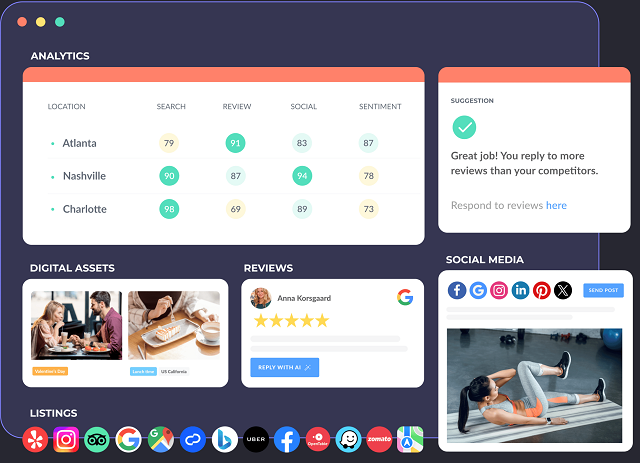
PromoRepublic stands out with its AI-powered content creation tools, helping agencies generate branded visuals, AI-generated captions, and industry-specific content suggestions.
- Key Features:
- Pre-made design templates for social media posts.
- AI-driven content recommendations based on engagement trends.
- Social media calendar management for better planning.
- Best for: Agencies that want content creation tools alongside scheduling.
Cloud Campaign – Ideal for Agencies with Automated Workflows
Cloud Campaign offers fully automated social media management, allowing agencies to run entire client accounts with minimal manual work. It’s built for resellers looking to scale efficiently.
- Key Features:
- Evergreen content recycling for continuous posting.
- Client-ready dashboards with full branding customization.
- AI-powered scheduling and automation.
- Best for: Agencies focused on automation and large-scale client management.
Vendasta – Full-Service Social Media Automation for Resellers
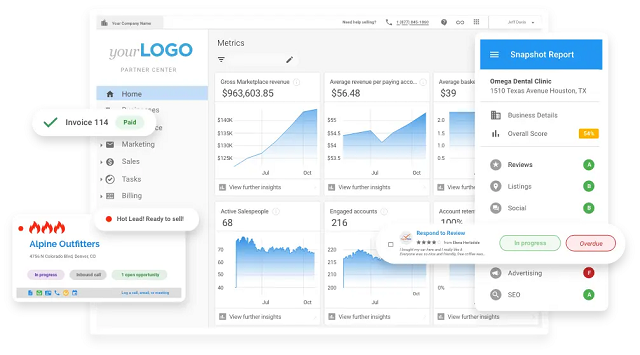
Vendasta is a white label social media software built for agencies, resellers, and digital marketers looking for an all-in-one marketing automation platform.
- Key Features:
- Pre-built white label solutions for social media, SEO, and PPC.
- Integrated social media posting tools with analytics.
- Scalable automation features for resellers handling multiple clients.
- Best for: Businesses looking for comprehensive digital marketing solutions, not just social media management.
The best white label social media services depend on business goals, budget, and client needs. For agencies looking for AI-powered automation, Cloud Campaign and PromoRepublic are excellent choices. If branding and client collaboration are priorities, Sendible and SocialPilot offer strong white label social media posting tools. Meanwhile, for resellers seeking full-service automation, Vendasta provides an all-in-one solution.
Using a white label social media management platform allows agencies and businesses to expand their offerings, improve efficiency, and maintain full brand control, ensuring a seamless experience for clients while scaling operations effectively.
White Label Social Media Platforms vs. Custom Development
When choosing between white label social media management software that is pre-built and developing your own platform, a business must consider its ability to scale, brand control, and long-term flexibility for clients. While “turnkey” sized solutions can provide a fast and cost efficient way to begin, they come with limitations upon growth and customization.
White label social media management software is meant for agencies who want an off-the-shelf software that is ready to use, and has features of scheduled posts, report analytics, and dashboard for clients. Platforms like these allow a business to use their own business name on the service, providing the same item for their clients without having to build it from the ground up. The big benefit is speed—only a few days are required for implementation, and hence it is well-suited for those agencies that must add services in a hurry. The drawback is that the solutions usually have limitations in the form of fewer features, and businesses are restricted to the capabilities of the software vendor.
Alternatively, custom solutions offer complete flexibility. Rather than having to conform to off-the-shelf software, businesses are able to build a fully branded, scalable solution that perfectly suits their business needs. Such solutions offer custom UI/UX to target audiences, enabling more interactive and personalized user experiences. It also provides complete control over monetization models, enabling businesses to offer subscriptions, content paywalls, or premium memberships without restriction.
For organizations needing full ownership and unlimited growth potential, bespoke development is the better choice. Although it requires greater initial investment, it allows for long-term scalability and total control over branding, functionality, and user data, making it a future-proof solution compared to off-the-shelf software.
⚖️ White Label Services vs. Scrile Connect
| Feature | Standard White Label Tools (e.g., SocialPilot, Sendible, PromoRepublic, Cloud Campaign, Vendasta) | Scrile Connect (Custom Build) |
|---|
| Branding | Limited white-labeling (logos, custom domains) | 100% custom UI/UX, designed for your niche |
| Monetization | Restricted to subscriptions, reselling licenses | Full freedom: subscriptions, PPV, tips, memberships, live-stream monetization |
| Scalability | Good for small/medium agency use, limited under heavy load | Cloud-based, built to scale from hundreds to millions of users |
| Features | Scheduling, analytics, client dashboards | Engagement tools, private messaging, monetization modules, live streaming |
| Data Ownership | Dependent on third-party APIs and policies | Full ownership of user data and platform logic |
| Security | Vendor-managed, often generic compliance | End-to-end GDPR compliance, encryption, fraud prevention |
| Revenue Control | Ongoing license costs, possible revenue cuts | No vendor cuts — you keep 100% of revenue |
| Longevity | Bound by vendor updates and roadmap | Future-proof — tailored to your goals and expandable via custom dev |
Scrile Connect: The Best Custom Development Solution

For businesses looking to launch their own branded social media platform, Scrile Connect provides a fully customizable development solution that goes beyond generic white label social media management services. Unlike off-the-shelf social media software, which often imposes branding restrictions, limited monetization options, and dependency on third-party APIs, Scrile Connect offers a tailored approach to social media management that ensures complete control, scalability, and flexibility.
Scrile Connect is designed for businesses that want to own and operate their own social media platform without relying on external software providers and delivers a fully customizable social media management experience:
- Advanced UI & UX Customization. Unlike standard white-label solutions, Scrile Connect allows businesses to fully design their interface, adapting it to their brand identity, user preferences, and specific niche market needs.
- Automated Content Scheduling & Publishing. The platform includes built-in social media posting tools, allowing users to schedule, automate, and manage posts across multiple channels without third-party integrations.
- User Engagement & Interactive Features. Scrile Connect supports real-time interactions, content monetization, and private messaging, creating an engaging social experience for users.
- Comprehensive Monetization Options. Businesses can implement subscription models, pay-per-view (PPV) content, premium memberships, tipping systems, and live-stream monetization, ensuring full revenue control without third-party restrictions.
- Scalable Infrastructure. Whether serving hundreds or millions of users, Scrile Connect’s cloud-based architecture ensures fast performance, high security, and seamless scalability.
- End-to-End Security & Compliance. The platform provides GDPR compliance, encrypted transactions, multi-factor authentication, and AI-driven fraud prevention, ensuring a secure and trustworthy user experience.
- Data Ownership & API Independence. Unlike traditional white label social media software, Scrile Connect allows businesses to retain full ownership of their user data and operate without relying on external API providers.
Why Scrile Connect Stands Out from Traditional White Label Social Media Apps
Many similar applications place constraints on use of branding, monetization decisions, and growth for business owners so they can operate only within those constraints. However, when you discover Scrile Connect, you have:
- Full Customization. Business owners will be able to customize every thing about their own platform so that it is a distinct experience and can customize based upon audience influence.
- Full Control over All Revenue. Business Owners will never pay a percentage of their revenue for a subscription to an app to utilize their own; therefore there would never be a rollback of revenue or take a sense of ownership from the process.
- Seamless Integration & Expansion. With our API, Business Owners can administer their customized integrations with other application applications and do so without increasing any operational costs to their business while they effectively add functionality to their service.
For entrepreneurs, small businesses, and agencies looking for a fully customizable and scalable social media engagement platform, Scrile Connect is your development partner.
Conclusion
While there are currently many white label social management services, businesses can find scalable management platforms of social engagement without having to try to internally build their own. The right path should be driven by the business plan in place and if in fact it needed a takeaway model, some custom development or niche development. Scrile Connect presents the best fully customizable platform to own their brand appropriately with better social engagement and sustainable monetization model.
If you are looking for a scalable social media platform; if you would like custom premium features; individualized data ownership; and ability to deeply customize, give Scrile Connect a try today!
Polina Yan is a Technical Writer and Product Marketing Manager, specializing in helping creators launch personalized content monetization platforms. With over five years of experience writing and promoting content, Polina covers topics such as content monetization, social media strategies, digital marketing, and online business in adult industry. Her work empowers online entrepreneurs and creators to navigate the digital world with confidence and achieve their goals.









































































